




In articles and letters discussing those components ofour public health system deployed to contain the now all too real threat ofbioterrorism,veterinary medicine is rarely mentioned.Yet veterinarians are positioned to contribute to the health and safety of human,as well as animal populations,in uniquely significant ways.Many ofthe pathogenic agents believed to be candidates for use by terrorists cause disease in animals and/or are carried by animals.
Veterinary epidemiologists study patterns of
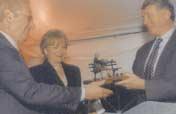
disease in animal populations to identify and monitor diseases potentially dangerous to man. In the case ofWest Nile virus infection,the discovery ofdead birds first alerted authorities to the possibility ofensuing human infections and to the need for stringent mosquito control measures.
When,in 1993,the Japanese Aum Shinrikyo cult released anthrax spores in a Tokyo building,there were no human deaths,but several pets succumbed to systemic anthrax,probably from licking their fur or other objects.In contrast to cattle,sheep,horses,and pigs,dogs and cats are not highly susceptible to anthrax. Nevertheless,these examples illustrate how affected animals,ifdiagnosed early,can serve as sentinels ofdisease,alerting physicians to the possibility ofhuman infection.
In addition to those viral and bacterial agents ofdirect public health concern,veterinarians protect our health and welfare by
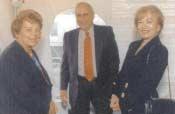
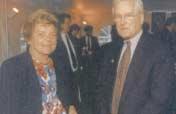
Agala reception honoring Herb and Ellen Moelis was held in a flowerfilled marquee adjacent to the Allam House at New Bolton Center on October 25th.The reception was rescheduled from the American Gold Cup in September,when it was cancelled due to the terrorist attacks on the World Trade Center and the Pentagon.
In spite ofgusty winds and the threat of falling temperatures,more than 100 people came to celebrate the Moelises,and their many charitable endeavors.In a wellillustrated tribute,Dr.Kelly highlighted Herb and Ellen’s efforts on behalfofthe School of Veterinary Medicine,Penn’s Library, Thoroughbred Charities ofAmerica, Freedom Hills Therapeutic Riding program and,more recently,the New York Heroes Fund.Herb,a 1953 WhartonSchool graduate and a member ofthe VeterinarySchool’s Board ofOverseers,gave a spirited response; but Ellen touched everyone when she recounted how their grandchildren,who the Moelises have been tutoring in the gentle art ofphilanthropy,spontaneously and unanimously agreed that their own little foundation should support the disaster relief fund in New York following the events of
September 11th.
Dr.Kelly presented Ellen with a lovely bouquet offlowers,and then recognized the tireless efforts of Betty Moran and the American Gold Cup for their continued
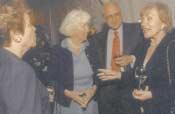
surveillance,prevention,and control measures aimed at highly contagious diseases that threaten the nation’s livestock and poultry industries. The agents offoot and mouth disease,avian influenza,and swine fever,to name a few,if introduced into the United States,would severely damage America’s agricultural economy and consumer access to affordable supplies ofmilk,meat,eggs,and poultry.Large animal veterinary practitioners can thwart acts of agro-terrorism by rapidly communicating suspicious infectious disease patterns to appropriate state and federal diagnostic laboratories and agencies,and by imposing appropriate animal handling and quarantine measures.
We must ensure that the same lines ofcommunication are readily accessible to veterinarians in companion animal practice.
Alan M.Kelly
The Gilbert S.Kahn Dean ofVeterinaryMedicine
generous support ofNew Bolton Center and the School ofVeterinary Medicine.Everyone voted the occasion a wonderful evening of fine food,drink and fellowship.



Funds for the new Teaching and Research Building are growing. Since August,an additional $2.5 million has been raised for the building.The total funds raised stand at $32.5 million,representing two-thirds ofthe estimated building cost of$48 million.
Several new significant gifts for the new building include:
Mrs.Ethel Carruth,a 1943 graduate of Penn’s School ofEducation,ofHouston, Texas made a gift of$1 million for a laboratory to support the work ofthe Center for Infectious Diseases and Food Safety Research. Mrs.Carruth and her late husband,Buddy,a 1942 graduate ofthe Wharton School,have supported the Veterinary School and the University for many years.They established an endowed scholarship,the Ethel G.and Allen H.Carruth Dean’s Scholarship,in 1992. Mr.and Mrs.Carruth bred and raised Santa Gertrudis cattle on their ranch in Texas. Mr.Carruth served for many years as president and chairman ofthe Houston Livestock Show and Rodeo and both were very active with the Houston SPCA.
The late Mary M.Opsuth ofTrenton,N.J., through her estate,provided at least $500,000 for a laboratory for medicine clinicians in the new building.This laboratory will enhance the interaction between clinical faculty and researchers in the basic sciences.Mrs.Opsuth was a long-time client at VHUP.She brought her poodles in many times to be seen by Meryl Littman,V’75,associate professor of medicine.Mrs.Opsuth so appreciated the care her pets received by Dr.Littman and the VHUP staffthat she made the provision in her will,“Because ofand as an expression of my sincere appreciation for the exceptional caring talent ofDr.Meryl Littman in the practice ofsmall animal medicine,and in my memory,I give,devise and bequeath… the remainder and residue ofmy estate to the School ofVeterinary Medicine.”Mrs.Opsuth died in 1999 at the age of89.The laboratory will be named in her memory.
Board ofOverseers member, Patricia Billhardt,completed her pledge of$250,000 for a classroom within the new building. Mrs.Billhardt,a prominent boxer breeder and exhibitor,and her husband,Jack,are long-time supporters ofthe School and have established four endowed scholarship that

bear her name.Billhardt has served on the Board ofOverseers since 1996.
Mrs.Emilie deHellebranth,through her estate,contributed $100,000 for the new Teaching and Research Building.Mrs. DeHellebranth,for many years,enthusiastically supported the work ofDr.Peter Dodson,professor ofanatomy.She provided funding for his dinosaur excavation expeditions to Montana and helped underwrite the dig in Egypt that yielded the humerus of Parallatitan stromeri,a giant sauropod.
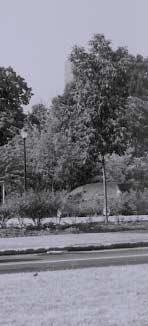
Planning is proceeding for the new Teaching and Research Building as faculty are refining their needs for the muchanticipated teaching and research spaces.
$48 million goal
$32.5 million raised
“One in five samples ofsupermarket ground meat and poultry bought for study was contaminated with Salmonella,and most ofthe strains were resistant to antibiotics.”
(A report on a scientific paper in the New England Journal ofMedicine, in The Philadelphia Inquirer,10/18/01)
Food safety is very much on everyone’s mind.Stories about unsafe foods,food poisonings,and rising antibiotic resistance oforganisms,have alarmed the general public.Food is no longer locally produced — the marketplace is stocked with fruits and vegetables from far-away states and countries. Cheeses come from across the continent and Europe.Meat products and fish originate in Europe.Fish and particularly seafood is farmraised in South America and Asia.The raising, selling and distributing offood is global and this makes it easier for harmful or resistant bacteria to travel from one country to another.
In response to the recent hoarding of antibiotics by the public,there have been many stories about the ability ofSalmonella and other organisms to develop into more and more drug resistant varieties.There is an ongoing discussion about drug use in the food animal industry worldwide and about allowing new,powerful antibiotics to be used in the raising offood animals.
Each year,millions ofAmericans suffer from food borne illnesses.Most cause mild discomfort,but they can be dangerous for immunosuppressed individuals and the elderly. The culprits often are bacteria; Campylobacter causes the highest incidence ofillness,followed by Salmonella, Shigella,and Escheria coli H0157.Most Campylobacter infections are associated with poultry,large numbers of which carry the microbe.Fortunately this microbe rarely causes outbreaks with sporadic or familial cases accounting for the greatest number ofinfections.
Is there reason to be worried? “Yes,”says Dr. Charles Benson,professor ofmicrobiology at the School.“These organisms are all around us. Even ifyou are a vegetarian,you can get infected by Salmonella as the bacteria can be on the skin offruit or vegetables grown in a field fertilized with manure compost.Bacteria and other harmful organisms have been in the environment for millions ofyears and they have survived because they can adapt to changed circumstances rather rapidly.”
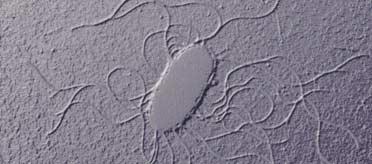
There are more than 30 antibiotics approved for use in food animals,some of these drugs are also approved for use in humans.Bacteria are exposed to these drugs and develop resistance to them.This resistance may be transferred in bits ofDNA from one bacterium to another and between different species ofbacteria.Such resistance is then passed on to the next generation and becomes established in the bacteria population. S almonella is the focus ofthe Salmonella Reference Center (SRC) which was established five years ago at New Bolton Center under the direction ofDr.Benson.Actually,the work on Salmonella at the School began many years earlier when it was realized that table eggs could act as a vehicle for the transmission of Salmonella enteritidis. Dr.Robert Eckroade, associate professor ofavian medicine and
background and training in reference and international disease surveillance. Dr.Donald S.Munro retired from the Scottish Salmonella Reference Laboratory (SSRL) in Glasgow and joined Dr.Benson’s group at New Bolton.He is an authority on the epidemiology ofSalmonellae.Dr.Shelley Rankin,also from the SSRL,is experienced in molecular epidemiology.
The Center provides diagnostic and reference service to the PADLS laboratories and serves the needs ofindividual practitioners within Pennsylvania.The Salmonella isolates samples are typed through a wide variety of techniques,including serotyping,phage typing, and antimicrobial resistance monitoring.In addition,molecular techniques such as plasmid profiling,restriction enzyme analysis ofthe bacterial genome and other tests are used to understand the dynamics ofsalmonellae trans-
pathology,and Dr.Benson,conducted many studies to determine how the bacteria could enter the egg prior to being produced by the chicken.They also developed a series ofpreventive measures that farmers employ to reduce the incidence ofSalmonella infection in chicken houses.These measures have greatly reduced the number ofinfected eggs.
The Salmonella monitoring program that was developed and put in place at New Bolton Center led to the establishment ofthe SRC which has become a valuable resource,not only for Pennsylvania farmers,but for other agricultural laboratories in the nation.The Center is part ofthe Pennsylvania Animal Diagnostic Laboratory System (PADLS);funding is received from the Pennsylvania Department of Agriculture,along with grants from USDA,the American Egg Board,and with revenue generated through client services.
The Center is staffed by specialists with
mission.SRC is one ofonly three laboratories in the United States which has the capability and expertise to provide such a detailed analysis ofthe samples.“Using this approach,we have been able to achieve a degree ofdiscrimination which has been previously impossible to achieve,”says Dr.Benson.“We can not only relate a strain to a given farm,but in some cases we can even identify which barn.”The Center also performs services for clients out of state.This yields an enormous amount of research material and generates a healthy income.
Each sample,once it has been completely typed,is deposited in the reference laboratory culture collection together with a complete record ofthe test data and available descriptive epidemiology.The collection is available to permit retrospective studies to be undertaken at such times as new serotypes appear in Pennsylvania.It represents a unique resource to the
state.“The services provided by the SRC provide an added dimension to the diagnosis and management control ofanimal associated human infectious disease and economically important animal diseases within the Commonwealth,”says Dr. Benson.
One ofthe important tasks ofthe SRC is the monitoring ofdevelopment ofantimicrobial drug resistance which poses a major threat to human and animal health.Generally it is perceived that such resistance developed because ofthe addition ofantibiotics to animal feeds,often at low levels,to enhance health and growth offood animals.“Not all antibiotic resistance develops in animals,”says Dr. Benson.“This has been clearly established as a result ofthe work carried out at the SRC.Every isolate submitted to us is tested for resistance to a range of13 antibiotics ofhuman and veterinary importance.This monitoring allows us to track the development and spread ofantibiotic resistance throughout the state.”A key conclusion from this surveillance activity is that resistance is not predicated on a simple cause and effect basis.These developments are multifaceted in nature involving a range ofcomplex interacting factors which include indigenous flora/dose/time/feed and the innate ability of the pathogen to change.The effects ofthese factors only begin to become obvious when large numbers ofbacteria are monitored over time.This work has attracted considerable interest,not only within the veterinary microbiology community,but also within human medicine and the pharmaceutical industry because ofthe implications raised.
The SRC laboratory has a quick turnaround time for samples submitted.Serotype and phage type resistance profile can be provided in 24 hours,core molecular data are available in an additional 24 hours.This becomes important ifan outbreak occurs — measures then can be taken quickly to contain it and to begin preventive steps to protect the other animals on the farm.
The SRC researchers also have the skill to take techniques developed for one genus and
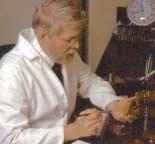
adapt them to other genera.This is quite important because there are many organisms that threaten the health offood animals and humans such as Listeria and Leptospira.
The SRC works closely with the School’s Center for Animal Health and Productivity (CAHP) and its field investigators to monitor infectious diseases on farms in the region. The Commonwealth has in excess of600,000 dairy cattle and this is one ofthe state’s main,ifnot the largest,agricultural industries.In a collaborative study ofthe incidence ofSalmonella infection on Pennsylvania dairy farms the SRC surveyed 100 randomly chosen farms and found that 14% were positive.Mortality in cattle covered by this survey ranged from 15%.This indicates that losses due to Salmonella in the Pennsylvania dairy industry could exceed $6,000,000.
Pennsylvania is unique in that it supports a large number ofdual enterprise farms.The SRC recently completed a study to determine the prevalence of Salmonella typhimurium DT 104,a particular drug resistant strain,in the environment ofa naturally infected dual enterprise farm.The real-time study allowed for quick development ofrecommendations to reduce the incidence and eventually eliminate the organism from the farm.
In most cases,further outbreaks ofSalmonella or other bacterial infections can be prevented by changes in husbandry on the farm.Clinicians from the CAHP make recommendations about disinfection ofareas where the animals are housed,about feed handling and rodent control,to help the farmer overcome the problem.Often it takes just a few changes in practices to eliminate the problem.
The SRC collaborates with researchers at other universities and laboratories,the Centers for Disease Control,the National Veterinary Services Laboratory,the National Antimicrobial Monitoring Service and the FDA as well as institutions abroad.The latter is particularly relevant because ofthe global nature offood production.SRC is working to become a part ofthe international surveillance network in the
field ofhuman enteric diseases.Its collection of more than 17,000 strains ofSalmonella from across the United States is a unique asset and enables the laboratory to conduct retrospective studies and monitor the development ofresistance to an enormous range ofantimicrobial agents.
SRC will be one ofthe founding members ofVet-Net,a veterinary monitoring service funded by the European Economic Commission,to be established within two years.Dr. Benson and his group are a vital part ofPADLS and they are doing their part ofkeeping the Commonwealth’s food supplies safe.One piece ofadvice from Dr.Benson:“Wash the fruits and vegetables before eating them.Cook meat and eggs thoroughly.Always wash utensils and cutting boards between usage for raw and cooked ingredients.And enjoy your meal!”
The Dr.Ginnie Leiblein Memorial Scholarship and the Westminster Kennel Foundation Scholarship were awarded to Patty Lathan,V’02 Amy Balcerzak,V’05 received a scholarship from the NCAA. Darah Resh,V’03 received a scholarship from The Lalitta Nash McKaig Foundation. The Barnstable County Agricultural Society,Inc.and The Coondog Scholarship Fund awarded scholarships to Kate Johnson,V’03. Emily Kuprion,V’03 received a scholarship from the Rotary District 7450 Gundaker Foundation.The Armour/Lewis Family Foundation provided scholarships to Micah Brodsky,V’02, Annette LePere,V’02, Colleen Kane,V’02, Karena Joung,V’03 and Kimberly Johnston,V’03.The William Goldman Foundation has provided scholarships to Gina Cairone,V’03, Edward Cooper,V’02, Melissa Geedey,V’02, Erin Mairs,V’03 and Karen Oberthaler,V’02 Christine Bohn, V’02 is the recipient ofthe Clifford R. Wright,Jr.Scholarship. Marcilyn Duman, V’02 was awarded the Iris M.McGee Scholarship. Danielle Springer,V’03 and Kathy Heim,V’04 have been awarded Anne Linn White Dean’s Scholarships. Frieda Rest,V’02 is the recipient ofthe Richard A. Dorr,Jr.Memorial Scholarship.

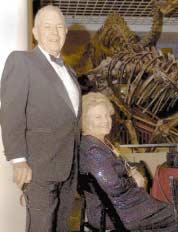
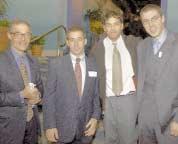
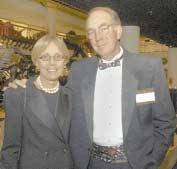
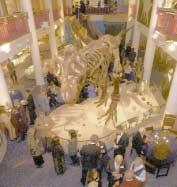
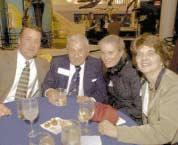
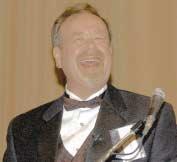
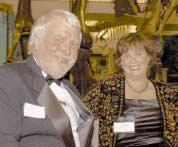
The 2001 Rush Shippen Huidekoper Society Dinner,which recognized the University ofPennsylvania School of Veterinary Medicine’s most generous donors and friends during the 2000-01 fiscal year,was held on Saturday,November 10,at The Academy ofNatural Sciences in Center City Philadelphia.Almost 150 guests enjoyed dining in the shadow ofdinosaurs in Dinosaur Hall, and attending a presentation by Dr.Peter Dodson,professor ofanatomy in the School of Veterinary Medicine and professor ofgeology in the School ofArts and Sciences.
Dr.Dodson enthralled everyone by discussing the recent dinosaur discoveries by him and his fellow Penn colleagues,including the discovery in 2000 of Paralititan stromeri,the second-biggest dinosaur known to have ever lived.This remarkable discovery in Egypt will be featured in a documentary, The Lost Dinosaurs ofEgypt,which will air on the A&E Network in the fall of2002.
Named after the first dean ofthe School of Veterinary Medicine,the Rush Shippen Huidekoper Society recognizes those donors who contribute $1,000 or above to the School in the fiscal year.The generosity ofthe School’s alumni and friends advances the School’s mission to better the health and welfare ofanimals and humans.The continued support ofthe School’s donors is an important vote ofconfidence in the School as it continues to build upon its more than 100 years ofpreeminence in veterinary teaching,research,and service.
For information on becoming a member of the Rush Shippen Huidekoper Society,visit the School’s Alumni & Friends web site at <http://alumni.vet.upenn.edu> or contact Joshua E.Liss at (215) 898-1481 or via e-mail at <lissj@vet.upenn.edu>.
Scientists at the School have successfully used a retrovirus to modify genes in spermatogonial stem cells in a mouse — the first instance,in any species,ofa transgenic animal created by inserting a gene into male germ-line stem cells.
The inserted gene subsequently appeared in approximately 4.5 percent ofoffspring ofmice transplanted with the altered stem cells,and was transmitted to at least three succeeding generations.
The work was the cover story in the Nov.6 issue ofthe Proceedings ofthe National Academy ofSciences.The findings should enable the creation oftransgenic individuals in a wide range ofspecies,permitting scientists to develop research models for study ofnumerous human diseases.
Led by Ralph L.Brinster,Richard King Mellon Professor ofReproductive Physiology at the School,the scientists succeeded in inserting a foreign gene — in this case the common reporter gene lacZ,whose product is the enzyme fl-galactosidase — into 2 to 20 percent ofmouse spermatogonial stem cells in laboratory experiments,a tenfold improvement over previous attempts.
“These results indicate that there is no intrinsic barrier to the genetic engineering of spermatogonial stem cells using retroviruses, and that once inserted,the foreign genes will continue to be transmitted and expressed from one generation to the next,”said Dr.Brinster. All male mammals harbor many spermatogonial stem cells,key repositories ofgenetic material whose daughter cells give rise after puberty to sperm.In the human male,approximately 1,000 sperm cells,each carrying a different combination ofgenetic material,are generated in this manner with each heartbeat. Whereas the female germ cell,the egg,stops dividing before birth,male germ-line stem cells continue to divide throughout life.
Ofthe various types ofstem cells,only two — spermatogonial and hematopoeitic stem cells — can be positively identified using functional assays.This makes them valuable models for other types ofstem cells,such as those that
give rise to skin,the lining ofthe intestines, brain,muscle and liver.
Spermatogonial stem cells are ofadditional interest for transgenics applications because they are the only cells,including all other stem cells,that undergo self-renewal throughout an animal’s lifetime and contribute genes to subsequent generations.Previous attempts to genetically alter this unique type ofstem cell, either through retroviruses or other methods, have met with little success.
Brinster’s work is unusual in that his transgenic mice were created using cells from male animals.Transgenic animals are generally produced by inserting foreign DNA into cells derived from females,such as oocytes,eggs and blastocysts.Brinster’s group has demonstrated that the efficiency ofgenerating transgenic mice through spermatogonial stem cells is roughly equivalent to that offemale-derived cells.
“Questions had been raised regarding whether male germ-line stem cells could be transduced with a retroviral vector and whether any gene introduced would be silenced,”Brinster said.“Our work clearly demonstrates that the stem cell can be transduced at relatively high efficiency and expression is not silenced.About 10 percent ofstem cells carry active genes that are transmitted for at least three generations.”
Retroviruses are the most common vehicles for introducing genes in human somatic cell gene therapy,and some scientists had expressed concern that this approach might result in genetic alterations to germ-line cells. Brinster’s paper indicates that the germ cells are indeed susceptible to insertion offoreign genes via retroviruses,although the somatic cells that surround stem cells in the body most likely provide a protective shield.
Brinster was joined in the work by Makoto Nagano,now at McGill University,and Clayton J.Brinster,Kyle E.Orwig,Buom-Yong Ryu and Mary R.Avarbock,all ofthe Department of Animal Biology at the School.Their work was supported by the National Institutes ofHealth, the Commonwealth and General Assembly of Pennsylvania and the Robert J.Kleberg Jr.and Helen C.Kleberg Foundation.
Saturday,January 26,2002
Saturday,March 23,2002
at the Veterinary Hospital ofthe University ofPennsylvania
3850 Spruce Street
Philadelphia
Registration for each symposium is $60 per person.
Advance reservations are required. Seating is limited.For further information plaese contact:
Josephine Deubler,V.M.D.,Ph.D. Veterinary Hospital ofthe University ofPennsylvania
3850 Spruce Street
Philadelphia,PA 19104
Tel.:(215) 898-8862
For a detailed program,go to <www.vet.upenn.edu/comm/news/ 2002symposium.html>
Reservations can be made electronically by going to the secure website <www.vet.upenn.edu/Administration/ businessandfinance/payment/>
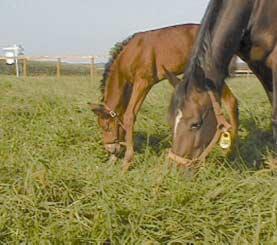
The three-year research investigation entitled Project M.A.R.E.,funded by the Pennsylvania Department ofAgriculture,was completed in June 2001. Drs.Perry Habecker, Fabio Del Piero, Tanya Lemire of the Department ofPathobiology at New Bolton Center and Dr.Helen M.Acland ofthe Bureau ofAnimal Health and Diagnostic Services,Pennsylvania Veterinary Laboratory in Harrisburg,Pa.were the pathologists representing the Pennsylvania Animal Diagnostic Laboratory System (PADLS) and performing the diagnostic test on specimens. Dr.Patricia L. Sertich ofthe Department ofClinical StudiesNew Bolton Center coordinated the project and was assisted by the project research technician Mr.Steve Kirschner. Dr.Raymond C. Boston performed the data analysis for the project.
At the onset,the study was assigned a name for presentation to the public in order to establish study awareness and memorable project recall. Project M.A.R.E.: Monitoring Abortions & Reproductive Efficiency in Pennsylvania would summarize certain aspects ofbreeding management and determine the causes oflate pregnancy loss in mares in Pennsylvania.Horse breeders and equine practitioners in Pennsylvania were solicited for participation in Project M.A.R.E. Registration in the study simply required a breeder to complete a survey that inquired about the management oftheir broodmares.Participation in Project M.A.R.E entitled the breeder to have a diagnostic evaluation and free necropsy ofthe conceptus ofany aborting mare.Participating veterinarians received information regarding the proper submission ofsamples from any mare that might experience spontaneous abortion.Veterinarians located in remote areas received fetal necropsy kits complete with a directional video,sample vials,and overnight postage.Over 350 breeders and 135 practitioners registered for the project and submitted diagnostic materials from nearly 150 aborting mares.There was a great variation in the number ofmares each farm managed (1 to 500 mares) but most breeders had less than 7 pregnant mares.Most (63%) ofthe farms did not have access to a stallion on their home farm.Greater than 23 breeds were represented in the study with the Thoroughbred (32%), Standardbred (13%) and Quarter Horse (11%) being the most frequent breeds represented in Pennsylvania.
A summary ofthe many aspects ofbreeding farm management was made during Project M.A.R.E. Breeders seem to be quite successful in getting their mares settled as past pregnancy rates were just over 75%.Although approximately 70% ofthe farms breed mares by natural cover,around one third ofthe farms use artificial insemination with fresh semen and slightly more than a third use artificial insemination with transported cooled semen. Only 5% ofthe farms use frozen semen to breed mares.Over 80% ofthe mares are examined for pregnancy ultrasonographically and at least 75% ofthe farms specifically have their mares examined for the presence oftwins. Iftwins are detected an attempt is made to manually reduce them on over 80% ofthe farms.Some farms allow twins to attempt to regress naturally but as many as 40% of the farms will terminate twin pregnancies with prostaglandin.In the four years preceding Project M.A.R.E. the farms participating in the study reported an total average of29 mares aborting twins each ofthose four years.
Although two thirds ofthe farms surveyed breed mares on their home farm,a little over a third ofthe farms send mares out of Pennsylvania for breeding.For mares being bred offtheir home farm,both those being bred in Pennsylvania and out ofstate,only about one third return to their home farm in less than a week after breeding.
Although only about 6% ofthe farms never vaccinate their broodmares against infectious diseases,most breeders do not provide their broodmares the best opportunity to produce high quality colostrum.Mares are able to produce higher quality colostrum ifthey are administered their annual vaccinations at approximately one month before their due date.More than halfofthe mares are administered vaccinations against rhinopneumonitis repeatedly during pregnancy.Current recom-
mendations are to administer rhinopneumonitis vaccine at 3,5,7 and 9 months ofgestation because the immune protection achieved from vaccination is short lived and needs to be repeated ifmares are to be protected against rhinopneumonitis abortion.Three quarters of the farms use a killed virus vaccine against the herpes virus that causes rhinopneumonitis. Unfortunately some mares do not appear to
have adequate immunity as their serum titers were found to be low when routine titers were evaluated during a pregnancy loss diagnostic work-up.Close to a third ofthe breeders do not utilize any veterinary service in maintaining a vaccination program and instead purchase their vaccines from a mail order service and have a layperson administer the vaccines. Although most breeders regularly deworm their mares during gestation,few took advantage ofthe effective safe opportunity to deworm just before breeding when there is no risk to the fetus and in the first few days after parturition.There is evidence that “foal heat diarrhea”can be prevented ifmares are administered anthelmintics soon after foaling.This will decrease the parasite contamination a newborn foal is exposed to as they are investigating their early surroundings.Two thirds ofthe broodmares are administered ivermectin and halfofall mares may receive pyrantel pamoate during pregnancy.Almost all breeders were careful not to administer vaccinations or anthelmintics during the first month ofgesta-
tion when the early embryo is undergoing important organ development.Slightly less than two thirds ofall broodmares have an annual Coggin’s test performed.Water is supplied to the broodmares on most breeding farms as groundwater from wells or springs. Only 7% use municipal water exclusively for their broodmares.
F ortunately more than 75% ofthe breeders were able to submit the entire conceptus from mares experiencing a late pregnancy loss. A diagnosis ofthe cause ofpregnancy loss was made two thirds ofthe time ifthe entire conceptus was submitted.Unfortunately,ifonly a necropsy kit was submitted,only halfofthe time was an etiology determined.Because of this finding,breeders should be encouraged to take the time and make the effort to send the whole fetus and the placenta to the laboratory. When this is not possible though,a necropsy kit submission is still ofvalue.Most mares had no history ofproblems during their pregnancy and only a quarter ofthem appeared ill at the time oftheir pregnancy loss.The presence of premature lactation or early mammary gland development is thought to be an indication of some problem during pregnancy.A third ofthe mares were noted to have mammary development before spontaneous abortion.Only 11% ofthe mares had a history ofprevious pregnancy loss.Just over 10% ofthe losses were associated with dystocia.
Problems that were associated with the late pregnancy loss are listed in follow table:
Placentitis.
Other placental abnormalities.
Bacteria Infection.
Rhinopneumonitis (herpes). .
rhinopneumonitis abortion.It is interesting to note that inadequate plasma titers against rhinopneumonitis were found in some ofthe vaccinated mares that lost their pregnancy due to some other cause.This information reflects the need to investigate the vaccination protocols that are being used.Prevention ofrhinopneumonitis depends not only on vaccination but proper management ofthe broodmares. Pregnant mares should be isolated from transient horses on the farms and kept in small closed groups.Mares foaling for the first time should be kept separate from pluriparous mares.
Efforts should be made to prevent bacterial infections in mares.Although a diffuse type of placentitis can occur in mares that develop septicemia,the more common type ofplacentitis
be administered antibiotics and agents to help support the pregnancy.These mares need to be carefully monitored at the time ofparturition as the inflamed placenta may fail to rupture spontaneously resulting in delayed delivery of the fetus and hypoxia.
Pregnant mares should be examined by palpation and ultrasonography per rectum at least two times before 30 days ofgestation to improve the opportunity to detect the presence oftwins.Mares found to have twins are best managed by manual reduction ofthe twins to a singleton prior to 30 days ofgestation.
Providing close observation prior to and during delivery can reduce pregnancy losses associated with parturition.Good,frequent communications with the farm’s veterinarian will help assure that obstetrical assistance will be available should a dystocia occur.
17%
18%
12%
11%
Developmental abnormality. . . 11%
Dystocia. .
10%
Umbilical cord Abnormalities. . 9% Twins. . . . .
Fescue. .
Nocardia Placentitis.
Leptospirosis.
Equine Viral Arteritis (EVA). . . 0%
Equine infectious anemia (EIA)0%
Although vaccination is recommended to help protect mares against abortion due to rhinopneumonitis,the vaccines are not 100% effective.In spite ofbreeding farms carefully following the veterinary recommendations for frequency ofvaccination,vaccine handling and administration some mares still experienced
is called ascending placentitis and develops from a local infection ofthe genital tract. Mares that have poor perineal conformation or lose significant body condition during pregnancy may be prone to developing an infection in the genital tract that slowly moves into the uterus and infects the placenta and may subsequently causes abortion.Changes that occur with placentitis can be detected and monitored by ultrasonographic examination.Keeping the mares in good body condition by providing good quality feedstuffs and moderate exercise can prevent this.An episioplasty or Caslick’s Operation can augment the function ofthe caudal genital tract to prevent contamination and chronic infection ofthe genital tract. Mares showing signs ofplacental infection may
Fortunately broodmares in Pennsylvania do not appear to be experiencing significant pregnancy loss due to fescue toxicosis,Nocardia placentitis,Leptospirosis or the Mare Reproductive Loss Syndrome that has been reported in Kentucky this 2001 foaling season. Project M.A.R.E. has identified problems associated with pregnancy loss in mares in Pennsylvania.Knowledge ofthis information can help in the organization ofproducer educational programs, encourage the use ofveterinary services to prevent and treat pregnancy problems,and direct future research projects investigating pregnancy loss. Project M.A.R.E. has identified what aspects ofbroodmare management are being optimally implemented and what areas need to be improved.Veterinarians in Pennsylvania are prepared to provide adequate information and samples to enhance the Pennsylvania Animal Diagnostic Laboratory System’s ability to reach a diagnosis.This laboratory and Dr.Sertich encourage continued collaboration with veterinarians and horse breeders in Pennsylvania to Monitor Abortions & Reproductive Efficiency in Pennsylvania.
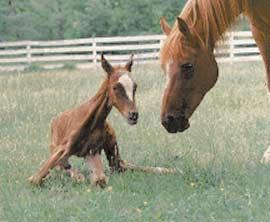
Dr.Adrian Morrison,professor ofbehavioral neuroscience,was elected President ofthe World Federation ofSleep Research Societies at its October congress in Punte del Este, Uruguay.Dr.Morrison has been invited to present The Walter C.Randall Lecture on Biomedical Ethics in April 2002 during the American Physiological Society (APS) Experimental Biology meeting in New Orleans,La. Recipients ofthese Distinguished Lectureships are chosen by the 12 APS Disciplinary Sections as outstanding contributors and representatives ofthe best research within their field.The Randall Lectureship,sponsored by the APS and Taylor University,promotes integrity in sciences,especially to students in training,and otherwise fosters the highest ethical standards in biomedical research,publication,teaching and interaction with the public sector.Dr. Morrison’s lecture is entitled “Developing an Ethical Position on the Use ofAnimals for Biomedical Research.”
Dr.Mark Saunders,V’81,associate professor ofradiology,was elected as president-elect ofthe American College of Veterinary Radiology at the 2001 ACVR Annual Scientific Meeting in Honolulu.He will serve as president-elect for 2001-02 and then move to president for 2002-2003.
Veterinary Anesthesiologists (ACVA).He and three colleagues from the University ofCalifornia presented three abstracts at the Annual Meeting ofthe American Society ofAnesthesiologists in New Orleans in October.Dr. Driessen and his co-investigators Drs.Cheung, Jahr and Gunther at the University ofCalifornia received a two-year NIH-BRG grant to develop new bioengineering methods for the in-vivo study ofblood substitutes.Dr.Driessen, Lawrence Nann,anesthesia technician supervisor,New Bolton Center,and Robin Benton, anesthesia technician,received a grant from Abbott Pharmaceuticals to conduct a clinical study comparing two inhalant anesthetics in horses.
Larry Nann spoke at the Academy ofVeterinary Technician Anesthetists/ACVA Meeting in New Orleans,La.,in October.His talk,presented to certified veterinary technicians who perform anesthesia on a regular basis,was titled “Zen and Understanding Your Anesthesia Machine.”He also organized and taught a wet
Leslie King, Sarin Sorenmo,and Robert Washabau,V’82 attended the meeting and presented papers.
Dr.Sue McDonnell,adjunct associate professor ofreproductive behavior,gave a series of seminars at the AAEP Encore in Philadelphia in July;at the Texas Breeder’s Forum,Aubrey, Texas,in August;at New Bolton Center in September;at the Iowa State Veterinary Association in September;at the AAEP San Diego,Ca., and at the Western Equine Reproduction Symposium in Solvang,Ca.in November. Dr.Katherine A.Houpt,V’63,ofCornell University and Dr.Nancy Diehl,V’91,ofPenn State University,co-taught the two day course at New Bolton Center in September.
The Oncology Service at VHUP was well represented at the 21st annual Veterinary Cancer Society meeting in Baton Rouge,La. Drs.Jennifer Baez,V’92,Janet Burke,V’98, Craig Clifford, Beth Overley,and Ms.Roxanne Bachman all presented abstracts at the meeting.
Dr.Billy Smith,assistant professor in clinical studies,presented three lectures at the annual conference ofthe New York State Veterinary Society in November.
Dr.E.Neil Moore,professor ofphysiology, was elected a Fellow ofthe American Heart Association and an inaugural fellow ofthe Council on Basic Cardiovascular Sciences of the American Heart Association.
Dr.Ilana Reisner,assistant professor of behavioral medicine,was an invited speaker at the“Canine Aggression:A Three Day Symposium”in November at the University of Guelph,Ontario.Her talk was entitled “The role ofneurobiology and impulsivity in canine aggression.In July,Dr.Reisner was an invited speaker at the AVMA meeting in Boston,and presented a talk entitled,“Anxiety and its role in old dog behavior problems:A no-brainer?”
Barry Stupine,vice dean ofthe School,has been named Chair ofthe Human Resources Committee and a member ofthe Executive Committee ofthe American Red Cross, Penn/Jersey Region.
Dr.Bernd Driessen,assistant professor of anesthesia,is a diplomate American College of
lab on “Veterinary Anesthesia Machines and Scavenging Systems.”The meeting was held in conjunction with and with support from the ACVA.Mr.Nann is a member ofthe Organizing Committee ofthe AVTA.This organization will hold its first certifying exams for Veterinary Technician Specialist in Anesthesia and Academy membership in October 2002.
Dr.Alexander M.Reiter,lecturer in veterinary dentistry,made six presentations at the 15th Annual Veterinary Dental Forum in San Antonio,Texas in October. Dr.Colin Harvey, professor ofsurgery and dentistry,also gave talks at the meeting.He was appointed secretary ofthe American Veterinary Dental College.
Dr.Ronald Harty,assistant professor of microbiology,received a five-year grant from NIH/NIAID entitled “Budding ofNegativeSense RNA Viruses.”
The School was well represented at the 7th annual FECAVA/FK DVG European Congress in Berlin,Germany in October. Drs.Urs Giger,
Dr.Jean-Pierre SaintJeannet,assistant professor ofdevelopmental biology,received a threeyear grant from the March ofDimes Birth Defects Foundation for a project entitled:“Sox9 activity during neural crest development”
Drs.Meryl Littman,V’75, Urs Giger and Paula Henthorn received funding from AKC-Canine Health Foundation for a project entitled: “Longitudinal field studies ofsoft-coated wheaten terriers affected with protein-losing enteropathy and/or protein-losing nephopathy,”and for the foundation ofa DNA bank.
The new date for the European Society of Veterinary Neurology meeting in Philadelphia is September 26 to 29,2002. Dr.Sheldon Steinberg,V’59,professor ofneurology,is the organizer.The meeting,originally planned for
some recent accomplishments of note at the School
Histologic Classification ofEpithelial and Melanocytic Neoplasms ofthe Skin of Domestic Animals. Dr.Tom Van Winkle,V’75, professor ofpathology,and Dr.Yvonne Schulman,AFIP,presented three hours on Histologic Classification ofTumors ofthe Nervous System ofDomestic Animals
medicine,presented eight hours ofcontinuing education seminars at the South American Society for Small Animal Specialists meeting in Montevideo,Uruguay in November.
The University ofTexas M.D.Anderson Cancer Center presented the 2001 Ernst W. Bertner Memorial Award to Dr.Ralph L. Brinster,V’60,Richard King Mellon Professor ofReproductive Physiology. Dr.Brinster was honored for distinguished contributions to cancer research.
The Ernst W.Bertner Award is conferred annually on a physician or scientist who has made distinguished contributions to cancer research.Established in 1950,it is the oldest award conferred by the M.D.Anderson Cancer Center.It is presented at the annual Symposium on Fundamental Cancer Research.
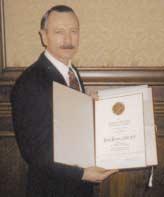
September 2001,had to be postponed.
Dr.Shelly Rankin,assistant professor of microbiology,received a two-year grant from the Commonwealth ofPennsylvania Department ofAgriculture to study “Genotypic Characterization ofAntibiotic Resistant Salmonella.”
Dr.Phillip Scott,professor ofmicrobiology and immunology,received the Bailey K. Ashford Award by the American Society of Tropical Medicine and Hygiene.The award, which recognizes distinguished work in the tropical medicine field,was presented at the annual meeting ofthe American Society of Tropical Medicine and Hygiene in Atlanta,Ga. in November.
At the First Annual C.L.Davis/AAVLD Diagnostic Pathology Symposium in November Dr.Michael Goldschmidt,professor ofpathology,presented three hours on
Dr.Robert Eckroade,associate professor of poultry pathology,traveled to Mongolia for four weeks in April for ACDI/VOCA as a Veterinary Curriculum Development Volunteer to review the curriculum and to aid in designing curriculum and suggesting changes and areas ofdevelopment.Dr.Eckroade also worked with government level officials and representatives ofveterinary associations and veterinary educators to draft the continuing education requirement ofa veterinary practice act.Dr. Eckroade traveled to Denver,Colorado in June for a NASDA meeting to evaluate the USDAAPHIS response to foreign disease outbreaks.
Dr.Virginia Reef,professor ofmedicine, spoke at the World Equine Veterinary Association meeting in Sorrento,Italy in October,the AVEF meeting in Paris in November and presented her fifth ultrasound laboratory at the AAEP meeting in San Diego,Ca.in November
Chung Lee,V’04,has been designated the Morris Animal Foundation’s Ballard Student representative.As a Foundation ambassador,a Ballard Student works to educate the student body and the faculty at the veterinary schools about the Foundation’s vital role in advancing veterinary medicine
Dr.Reid Groman,lecturer in critical care
Dr.Alicia McKnight,resident in radiology, presented a talk entitled “The Feasibility of Standing Equine MRI-Work in Progress”at the Annual Conference ofthe American College of Veterinary Radiology in Honolulu in August.
Dr.Mark Rondeau,resident in medicine, won first place in the 2001 Eukanuba Veterinary Diets Case Report Competition.Second prize was won by Dr.David Puerto,lecturer in surgery.
Dr.Heather DeHeer,staffclinical pathologist,is a diplomate ofthe American College of Veterinary Pathologists. Dr.Jennifer Bouma, V’97,lecturer in radiology,is a diplomate ofthe American College ofVeterinary Radiologists. Dr.Mark Krecic,lecturer in medicine,is a diplomate ofthe American College ofVeterinary Internal Medicine.
Drs.Colleen Brady,Deborah Silverstein and Rebecca Syring,all lecturers in emergency and critical care medicine,passed their boards and are now diplomates ofthe American College of Emergency Critical Care.
Dr.Margaret Sleeper,V’93,has accepted the position ofassistant professor ofcardiology.
Dr.R.Avery Bennett joined the faculty at VHUP in December as associate professor of surgery.
Dr.Jennifer l.Baez,V'92,lecturer in oncology,is a diplomate ofthe American College ofVeterinary Oncology.
The European College ofVeterinary Diagnostic Imaging (ECVDI) has recently approved the University ofPennsylvania School ofVeterinary Medicine as an official residency training center in diagnostic imaging.The ECVDI is the analogous European organization to the American College ofVeterinary Radiology (ACVR).
The University ofPennsylvania is the first ECVDI training center in America. Dr.Tobias Schwarz,who is a diplomate ofthe ECVDI,and Dr.JeffWortman,who is a diplomate ofthe ACVR,co-direct the ECVDI residency program.
It is now possible for the School’s radiology residents to simultaneously fulfill the requirements to sit for both the ACVR and the ECVDI certifying examinations in the third year ofthe residency.This ECVDI residency program is another example ofthe strong European bonds with the University ofPennsylvania School ofVeterinary Medicine.
Two first year radiology residents, Dr.Yael Mosenco and Dr.Allison Zwingenberger,have already enrolled in the ECVDI residency program.
More information about ECVDI can be found under:http://www.vet.gla.ac.uk/EVDI/ecvdi.htm
Working with sleep-deprived fruit flies, scientists at the University ofPennsylvania have uncovered the first molecular pathway,in any species,implicated in the shift between rest and wakefulness.
The findings,from a team led by Joan C. Hendricks ofPenn’s Center for Sleep and Respiratory Neurobiology were reported in the November issue ofthe journal Nature Neuroscience.The work indicates that a Drosophila melanogaster gene known as CREB — evolutionarily conserved in species from flies to humans — plays a role in rest’s rejuvenating effects,apparently permitting sustained wakefulness.
Anyone who’s ever pulled an all-nighter knows by the next morning that sleep is essential,and sleep’s status as a behavior found in organisms ranging from fruit flies to frogs to humans underscores its importance as a biological process.But 50 years after the discovery ofREM sleep,scientists still know little,on a molecular level,about why sleep is needed and the exact benefits conferred by a daily period of rest.
The Penn researchers say that in addition to offering answers to such fundamental questions,the new work could help improve the efficacy and safety ofthe ways people alter their sleep patterns.
“Ifwe can get at basic mechanisms ofhow sleep is normally controlled,and what it does
Donna M.Carlson has been appointed director ofdevelopment for VHUP.
Ms.Carlson served as director ofdevelopment for Eagleville Hospital for three years.Previously she was in several positions over a six-year period at Holy Family College.She received her undergraduate degree in economics from Holy Family College.Donna owns a great Pyrenees and has been a VHUP client.

for us,we can start to think ofhow to control, manage and improve sleep,”said Hendricks, the Corinne R.and Henry Bower Professor of Medicine at the School.“This would be helpful for people subjected to changes in sleep schedules and for people with sleep disorders.”
Hendricks’group first described Drosophila sleep in a paper published last year in the journal Neuron.Rest in flies shares numerous similarities with human sleep,including prolonged immobility,decreased sensory responsiveness and a need to compensate after sleep deprivation.Fruit flies spend about six to 10 hours a day resting,mostly at night.
“The sleeping flies lie prone in a quiet corner,unresponsive to stimuli,for bouts averaging about 45 minutes but sometimes lasting up to two-and-a-halfhours,”Hendricks said.“These sessions are interspersed with very brief,one- to two-minute interruptions, during which they eat and groom and then settle back down.”
The Penn researchers’new findings indicate that the activity ofCREB,short for cyclic AMP response element binding protein,is inversely related to the physiological urge for rest.The need for sleep after a phase ofdeprivation — attained through the mechanical agitation of fly habitats roughly every 15 seconds for as long as six hours — surged in flies whose CREB activity was blocked.In normal flies, CREB activity remains elevated for some 72 hours after such a prolonged period ofwakefulness;CREB mutants slumber even longer than normal flies in the aftermath of deprivation.
CREB,which is evolutionarily conserved in species from slugs to mice to humans and
already known to function in cyclic AMP signaling,is also known to play an important role in learning in fruit flies.Hendricks’work could strengthen the link that many researchers believe exists between rest and the consolidation ofmemory.
The Penn group is continuing its studies of how CREB is turned on,as well as the target genes affected by its activity.They suspect that CREB activation during rest may somehow optimize the function ofthe central nervous system during waking hours.
Hendricks’co-authors on the Nature Neuroscience paper are Julie A.Williams, Karen Panckeri, David Kirk and Amita Sehgal,all of Penn,and Marcela Tello and Jerry C.-P.Yin of the Cold Spring Harbor Laboratory in New York.Their work is funded by the National Institute ofHeart,Lung and Blood and the Howard Hughes Medical Institute.
Dr.Paula Henthorn,associate professor ofmedical genetics,received a three-year grant from the Morris Animal Foundation to continue studies ofcystinuria in the maned wolf.The maned wolf,a threatened South American canid species,has a high incidence ofthis hereditary disease that results in cystine stone formation.The study is an extension ofthe ongoing studies ofcystinuria in dogs.The preliminary studies were carried out by James Kehler,V’02,a student in the School’s V.M.D./Ph.D.program.It is worth noting that Dr.Kenneth Bovee studied cystinuria in the maned wolfback in the 1970’s and 1980’s,and that the Metabolic Screening Laboratory in the Section ofMedical Genetics has been providing urine screening for the past 20 years as a service for North American zoos and wildlife sanctuaries that maintain maned wolves.The current studies are an extension these previous studies,and we can now use molecular genetics approaches to understanding the disease.
For Diana Chang,V’05,receiving an Opportunity Scholarship to the University ofPennsylvania School ofVeterinary Medicine has been much more than a badlyneeded source offinancial aid.It has been a sense ofgratification.
“It’s a great honor because it’s like someone reaching out their hand to you to help you along.It’s an amazing feeling,”says Ms.Chang.
The Opportunity Scholarship Program pairs each donor,who commits to giving $2,500 per year for four years—a total of $10,000—to a single student,who is selected based on strong academic qualifications and financial need.Since the program’s inception in 1998,40 Opportunity Scholarships have been awarded.
Dr.Charles W.Raker,C’41 V’42,chairman ofthe Opportunity Scholarship Program Committee,adds that the beneficiaries are “students
$10,000 is at least $15,000 on payback,”she says. Opportunity Scholarships also benefit the School,explains Dr.Raker,by luring competitive students who might otherwise not consider Penn due to its high tuition in comparison to the public veterinary schools.“By offering some scholarship aid,we can maybe turn the tide and have them come to Penn and not go to some other veterinary school.”
Scholarship donors may submit preferences for their recipient students,which aids in enhancing the mentoring relationship.For example, Ms.Chang’s sponsors, spouses Drs.Andrew P. Nebzydoski,V’84,and Patricia A.Morgan,V’85,asked that their student recipient be from Northeastern Pennsylvania and be interested in large-animal work.
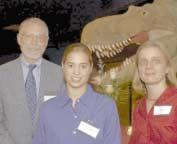
Drs.Smith and Craig met Ms.Moore at the 2001 Rush Shippen Huidekoper Society dinner, held in recognition ofthose donors who contribute $1,000 or more to the School in the fiscal year.The event,held November 10 at the Academy ofNatural Sciences in Philadelphia,also featured a presentation by Dr. Peter Dodson on recent dinosaur discoveries.
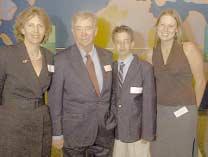
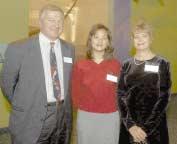
who we feel would be a credit to the profession and to the alumni ofthe University of Pennsylvania.”
For Ms.Chang,a Taiwanese immigrant who is funding her veterinary education entirely on student loans and scholarships,the award has meant not having to work part-time while in school.Opportunity Scholarship funds have also spared Mary Ellen Hennessey,V’05,from having to juggle school and a job.“I need all the time I have to study,”she says,“and I know I couldn’t do it with a job.”
Recipient Brooke Moore,V’05,who is also borrowing the entire tuition amount,less scholarships,notes that the financial benefit ofher Opportunity Scholarship is far greater than the face value ofthe funds.“With interest,that
Each student in the program is also paired with a mentor who is either his or her donor(s) or a faculty member.Dr.Raker,for example, has offered advice on summer jobs in the veterinary field to the student whom he sponsors and mentors.In his mentorship ofa second student— whose sponsor is not a veterinarian—Dr. Raker hopes to help the third-year student in his pursuit ofan equine residency.
Dr.Suzanne J.Smith,V’82—who,with her husband Dr.Peter H.Craig,V’55 G’85,sponsors and mentors Ms.Moore—hopes the student spends some time at Dr.Smith’s mixedanimal practice in Milford,N.J.“I hope this is a place she can run to when she needs to get reanchored to where her future is going to lead her in practice,”she says.
Dr.David P. Martin,V’66,who met his and his wife’s student recipient,Ms.Hennessey, at the dinner,says the scholarship program provides an added benefit to donors:“It caught my imagination as something that was really neat to see in a single person rather than to just give money that goes into this big nebulous pot.”
Craig,who recalls that the tuition cost was just $165 a semester when he went to veterinary school,is pleased with the opportunity to provide essential tuition assistance to Ms.Moore. “The help she’ll get from this will not only benefit her now,”he says.“It’s really going to launch her future.”
As for the future of the Opportunity Scholarship Program, the original 13 scholarship recipients will graduate this year.Dr.Raker and his fellow committee members are already contacting the donors of those scholarships to renew their support,and they hope to add on ten new scholarships this year.
Joan Capuzzi Giresi is a writer and a veterinarian in the Philadelphia area.
For more information or to receive a brochure on the Opportunity Scholarship Program,please contact Joshua E.Liss,Director ofAlumni Relations and Annual Giving,at (215) 898-1481 or via e-mail at <lissj@vet.upenn.edu>.
At 1:00 PM on September 11, Dr.Cynthia Otto, associate professor ofemergency and critical care medicine at VHUP,stopped her hospital routine and became a government employee for nine days.Dr.Otto,a member of the Pennsylvania Task Force 1,one of28 Urban Search and Rescue Teams in the nation,was “activated”to be deployed to the destroyed World Trade Center complex in New York.
The team of62 people is trained to deploy in six hours,selfsustain for 72 hours,and operate 24 hours a day.The team and the dogs are specifically trained for search and rescue after a building collapse.Teams were established by the Federal Emergency Management Agency to be deployed after natural disasters such as hurricanes and earthquakes.The Pennsylvania Task Force has been in existence for eight years and was first deployed during Hurricane Floyd.A team is made up ofsearch and rescue,medical, technical and logistics personnel.There is no official team position for a veterinarian,but the experience in New York shows how necessary a veterinarian is at a disaster site.The team includes four highly trained search dogs and their handlers,firefighters specially trained for rescue,paramedics and physicians.
“After a delay at the Lincoln Tunnel for a bomb scare,the team arrived at the base of operations,the Javits Center,about midnight,” said Dr.Otto.“We unloaded our two semitrailers ofgear and equipment and set up an impromptu home.By 3 AM we were ready to
Teams at disaster sites are put under the command ofthe local authorities.Here it was the New York Fire Department. The team was divided into two work groups,the day shift and the night shift. Dr.Otto became part of the night shift because it was decided that local veterinary care would be harder to obtain during the night.Two dogs, Logan,a German shepherd,and Bear,a Labrador retriever,were on the shift. The team had a forward base ofoperations in the Merrill Lynch Fitness Center at Ground Zero. The space had been damaged,but it was functional.The base was in close proximity to that ofthe New Jersey team,so Dr. Otto kept an eye on their dogs and other dogs that were in need ofcare.
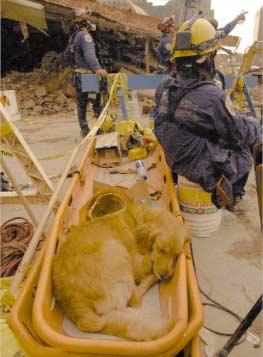
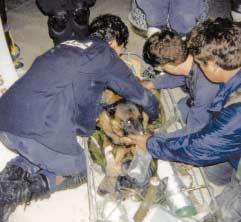
“What was a typical night at Ground Zero?”said Dr.Otto.“The night shift would load up on buses or military vehicles for the trip to Ground Zero.The streets were lined with New Yorkers cheering on the workers.It was a powerful way to start a shift.The busiest component ofthe team was the search component,the dogs and also technical search (using specialized search cameras and listening devices).The dogs would be sent out to the “pile”with the handler.They would search areas ofrubble looking for live victims.Although they are trained for “live find,”it soon became evident that the dogs were also able to identify remains of victims.”
The conditions under which dogs and people worked were dangerous.They had to maneuver on a huge pile ofbuilding debris, where gigantic steel beams rested precariously, one on top ofthe other.They had to watch their footing and be prepared for sudden holes. There was smoke,noise ofhuge cranes and hauling equipment,dust,and a great variety of odors.Everything was bathed in incredibly bright light from the many high-powered lights on the site.The humans wore masks and protective shoes and clothing.The dogs could not have masks nor could they work in booties — thousands ofwhich had been donated by a well-meaning public — because they needed to feel the terrain with their feet to avoid accidents.
The dogs were constantly called to search and this contributed to dehydration and exhaustion.“I gave a lot offluids,subcutaneous and IV,”said Dr.Otto.“We tried to rest the
dogs as much as possible and get them to drink water.These are very intense dogs,they are driven and will work until they drop.So dehydration was a big danger.The other dangers were the dust and the noxious fumes.I rinsed their eyes every 30-45 minutes.Their feet too were washed at that time to flush away the fine dust.I bandaged wounds and treated minor cuts on site.More serious problems were treated by the Suffolk County,N.Y.,SPCA van that was used by the Veterinary Medical Assistance Team (VMAT),located about five blocks from Ground Zero.”
The VMAT team is one offour that exist in the nation,these teams are based in Massachusetts,Maryland,North Carolina and California. They are made up of15 to 20 veterinary personnel.The team also provided a decontamination facility where the dogs were bathed at the end ofeach shift to remove the dust and debris from their coats.
Dr.Otto said that the rare critical animal was evacuated to the Animal Medical Center,New York City.She said that “Despite all ofthe risks, the dogs had minimal problems.The biggest problem seen was dehydration,probably a result ofoverwork.Cut pads were remarkably infrequent despite the sharp debris.The dogs were tired and because they were not finding live victims,they did not have opportunity to play,their normal reward for a find.”
To keep the dogs’ spirits up,the team organized searches in a near-by park.A person would hide and the dog would find it.Then it was playtime.“Many people volunteered to hide,”said Dr.Otto.“It gave them a release and it helped the dogs.The dogs also became therapists to the many people who worked at Ground Zero.They were petted and talked to,they momentarily distracted people from the horrendous scene.The need for this interaction led to therapy dogs being brought to Ground Zero to interact with the rescue personnel.”
The night shift ended around 8:30 AM when the team was transported back to Javits Center for rest.The dogs went to sleep pretty easily,but the humans did not.They were camped out on the floor,in sleeping bags — it was light,noisy and busy.“We got about three to four hours ofsleep each day before we started our shift again,”said Dr.Otto.
The tour ofduty ended on September 19th when the Pennsylvania team was relieved by a team from Texas.“It was a hard time,but a powerful time,”said Dr.Otto.“The swell ofsupport from the citizens ofNew York and the entire
country was incredible.Daily we would receive emails ofsupport,letters from children and encouragement from strangers.The Spirit of America has risen and will not be beaten down.”
There were approximately 350 dogs in Manhattan working at Ground Zero.They made around 900 visits to the mobile VMAT clinic.Some ofthese dogs belonged to the 21 Urban Search and Rescue Teams deployed there.Five such teams were deployed to the Pentagon site.Dr.Otto observed the conditions at the site first hand and worked in the dust, smoke,and air full ofnoxious odors coming from a myriad ofburning chemicals and substances.The long term effect ofsuch exposure remains to be seen.Dr.Otto has designed a three-year study to follow the dogs who worked at Ground Zero to determine whether the exposure at the site will affect the dogs’ health in the long term.The study will be funded by the American Kennel Club,the AKC Canine Health Foundation,Ralston Purina, and Veterinary Pet Insurance.
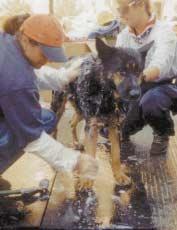
These dogs,in addition to their work right after the disaster,may contribute in the future in their role as sentinels for health problems that may be encountered later by the firemen, policemen,the rescue personnel,and the construction workers who worked at the site from the beginning.One can only hope that the effects will be minor and not long term.The study may provide answers in three to four years.
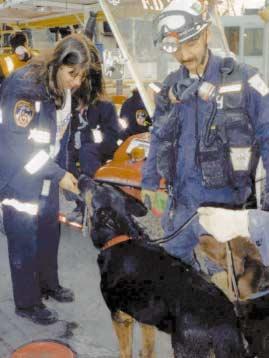
Dr.Sally Walshaw’s interest in all animal species has provided her a life of diverse experiences in veterinary medicine.She is currently the acting director of University Laboratory Animal Resources at Michigan State University.Dr.Walshaw grew up in Nebraska,moved to New York as a high school senior,and received her B.A.in biology from Manhattanville College in Purchase,N.Y., in 1966.Dr.Walshaw worked as a lab assistant in biochemistry for the Sloan-Kettering Cancer Institute in New York City,where an advisor suggested she further her education through a master’s degree.
In 1968,she received a M.A.in biology from Hunter College in New York City.Dr.Walshaw’s graduate work developed her interests in comparative biology,such as species characteristics,physiology,and ecology.Her interest in becoming a veterinarian stemmed from her perception that “veterinary medicine offered a scholarly opportunity and a practical approach to problems in various animal species and ecosystems.”
Dr.Walshaw then pursued a veterinary education as an in-state applicant to Cornell University.According to Dr.Walshaw,a professor on Cornell’s admissions committee told her, “you have an excellent academic record,it’s too bad that you are a woman.”Although her first choice school rejected her at a time when women were not admitted in large numbers to veterinary school,Dr.Walshaw was Penn’s gain in 1971.
As a student,Dr.Walshaw felt that Penn’s veterinary program was designed to “give her the best education possible,”and she enjoyed positive experiences through the School’s faculty-student mentoring program.She viewed her elective classes and rotations as opportunities to optimize her limited experiences with large animal species.Dr.Walshaw received her V.M.D.in 1975,and completed a small animal internship at Penn in 1976.
Dr.Walshaw explored clinical work at a private practice in Michigan,and then began her long-standing association with Michigan State University (MSU),teaching in the veterinary technology program from 1978 to 1987.In 1987,Dr.Walshaw accepted the position of
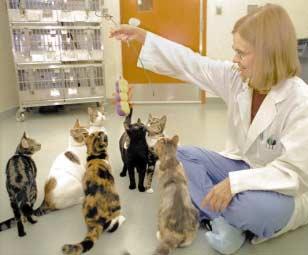
training coordinator for the laboratory animal unit at MSU.She views “teaching as a joy and privilege.”Currently,she is an associate professor ofsmall animal clinical sciences,teaching undergraduate,graduate,post-doctoral,and veterinary students to refine their laboratory animal techniques.Students and faculty practice first on a variety ofmodels,such as homemade,baby-sock,mice models,before performing procedures on research animals.
By comparing experiences with her Penn classmates,Dr.Walshaw realized the importance ofthe human-animal bond among those who enter the field ofveterinary medicine.She finds “many aspects ofthe bond fascinating,”considering that the bond is not exclusive to any particular species.Involved with human-animal bond activities since 1981,Dr. Walshaw has been the secretary for the American Association ofHuman-Animal Bond Veterinarians since 1997.She also provides presentations on animal death and human emotion for pet owners,veterinarians and veterinary technicians,laboratory animal workers,and animal shelter workers.In addition,she has a strong interest in the humane treatment oflaboratory animals.
Dr.Walshaw also is an adjunct professor in the MSU Center ofEthics and Humanities in
Life Sciences,providing services to the undergraduate,medical,veterinary,and nursing colleges.In 2000,she became the acting director ofUniversity Laboratory Animal Resources at MSU,involving the management oflaboratory animal care.She oversees an outreach program promoting public understanding about laboratory animal medicine through tours ofthe facilities.As a writer,Dr. Walshaw has co-authored Manual of Clinical Procedures ofthe Dog,Cat,and Rabbit,contributed chapters on Rabbit Behavior and Rabbit Euthanasia in the Manual ofRabbit Medicine and Surgery, and published articles in scientific journals.
Dr.Walshaw lives with her husband, Richard,whom she met during his residency in small animal surgery at Penn.Richard is the section chiefofSmall Animal Surgery and a professor in the Department ofSmall Animal Clinical Sciences at MSU.They have a daughter,Patty,who graduated in 2001 from Penn and who is now studying at Temple University to be a psychologist,and a son,Dan, who is in high school.Dr.Walshaw looks forward to retirement,as she hopes to study Spanish and an Asian language.Additionally,she intends on further exploring her interest in all species through hiking and aquatics expeditions.
Iam privileged to have the honor to work on behalfofthe School ofVeterinary Medicine’s alumni as the 2001-03 president ofthe Veterinary Medical Alumni Society (VMAS).I am a small animal practitioner in the New York City area,and the son ofJack Bregman, V’66.

We have a wonderful group ofalumni who serve on the VMAS Executive Board,including several new members who are recent graduates from the 1990s.This year’s new members are Kimberly Dawn Ashford,V’97; Stephen P. Butler,V’84; St.George Hunt,V’86,who serves as the alumni representative on the School’s Admissions Committee; Anita Impellizeri,V’97; Lori Spencer Mann,V’95, who serves as the alumni representative on the School’s Long Range Planning Committee; Shannon D.Shank,V’99;and James V. Stewart,V’68,who is president-elect ofthe VMAS and is the chairperson ofthe Alumni Liaison Committee.
A new development for the upcoming year is a change in location for Alumni Weekend.The Executive Board is excited to announce that Alumni Weekend 2002 will be held in Philadelphia exclusively for the first
On September 29,2001,members ofthe Class of1981 celebrated their 20th year reunion at the home of Michael J.Herman, V’81,and his wife,Janice,in Worcester,Pa. Those in attendance included,from left to right, Paul V.Marino,V’81,and his wife, Anna-Ghilaine Schless; David K.Lukof,V’81; Dolores M.Holle,V’81, Pamela J.McKelvieSmith,CW’75,V’81; Richard M.Levine, V’81, Michael J.Herman,V’81, Mark D. Newkirk,V’81;and Judith A.Durkee,V’81
time in more than six years.A fun-filled day is planned that will include a continuing education course,VMAS Annual Meeting, Alumni Day Picnic,participating in the Parade ofClasses,tours ofVHUP,and an allalumni dinner honoring the 2002 reunion classes (years ending in “2”or “7”) at the University ofPennsylvania Museum of Archaeology and Anthropology.We hope that all ofyou will appreciate this change of scenery,and will make plans to join us on Friday,May 10-Saturday,May 11.For more information,see page 21.
The School is experiencing a wonderful period ofgrowth.There are several projects underway,including the renovation ofthe VHUP wards and the construction ofthe new Scott Equine Sports Medicine Building at New Bolton Center.All ofthis work,along with the planned new Teaching and Research Building,will greatly benefit the education of today’s students.
In conclusion,I would like to say that I am very pleased and proud to be working on your behalffor the next two years.We appreciate any input that you may have.Please feel free to contact me via e-mail at <ebvmd@aol.com> with your comments and suggestions.For more information on the VMAS,please visit the School’s Alumni & Friends web site at <http://alumni.vet.upenn.edu>.
I hope to see many ofyou at the Penn Annual Conference in January.Have a wonderful holiday season and a happy new year.
Martin H.Ravitch and his wife,Reba,were recently profiled in a San Antonio Community Hospital publication as contributors to the hospital in Upland,Calif.,where they have lived since 1976.According to the article,the Ravitches traveled on more than 100 cruises during the 1980s.
Jack K.Robbins,his wife,and their four sons,who are all active in the horse racing industry,received the Commissioner’s Cup from the National Thoroughbred Racing Association (NTRA) in November 2001.The Commissioner’s Cup is presented annually to honor an individual or group for extraordinary contributions to the NTRA and the Thoroughbred industry.According to NTRA Commissioner Tim Smith,“Jack Robbins has been a key supporter during the NTRA’s creation and development,and his family’s contributions— whether on the racetrack,in executive offices or in the legal realm—offer further evidence of why this extraordinary family was chosen for this award.”Dr.Robbins is a longtime equine practitioner at California racetracks.He is a member ofthe The Jockey Club and a director ofthe Grayson-Jockey Club Research Foundation.Dr.Robbins is a past president and a Distinguished Life Member ofthe American Association ofEquine Practitioners.
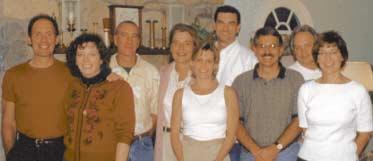
Elizabeth Atwood Lawrence made a
continued on page 18
presentation,“The History ofLivestock Projects in Developing Countries,”during the annual meeting ofthe American Veterinary Medical History Society at the American Veterinary Medical Association (AVMA) Annual Convention in July 2001.
1957
M.Phyllis Lose,who has practiced equine medicine for the last 45-years in Bensalem,Pa., and who has authored several equine books,is the owner ofOscar,a small white mixed terrier, who will be starring in a new motion picture, “Crimebusters,”to be filmed at Universal Studios in Orlando,Fla.
1958
The Florida Veterinary Medical Association (FVMA) honored Russell J.Snyder with a Lifetime Achievement Award at its annual convention in September 2001.The award is given to senior members who have made outstanding contributions to the FVMA and veterinary medicine.Dr.Snyder has been an active member ofthe FVMA since he joined in 1960,and
More than 60 School ofVeterinary Medicine alumni and their guests attended an alumni reception during the American Association ofEquine Practitioners’47th Annual Convention in San Diego on November 25,2001.Penn alumni enjoyed the opportunity to renew old friendships and make new ones at the largest equine veterinary meeting in the world.Dean Alan M.Kelly gave alumni an update on recent activities at their alma mater.
has served as president ofthe Jacksonville Veterinary Medical Society twice.
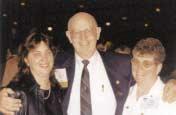
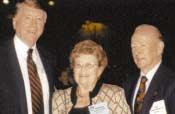
1960
Walter M.Woolf was also recognized by the FVMA with a Lifetime Achievement Award at its annual convention in September 2001.Dr. Woolfhas served as president ofthe Hillsborough County Veterinary Medical Society and the Pinellas County Veterinary Medical Society. He and his wife,Millie,also own Air Animal, Inc.,an animal transportation company.Dr. Woolfhas been active in this industry,serving as president ofthe Independent Pet and Animal Transportation Association,and currently as president ofthe Animal Transportation Association.
Suzanne Ruch Jenkins received the 2001 Helwig-Jennings Award from the American College ofVeterinary Preventive Medicine during its annual meeting at the AVMA Annual Convention in July 2001.The award is given in
recognition ofoutstanding and prolonged service to the College.
During the Pennsylvania Veterinary Medical Association’s (PVMA) Annual Meeting in August 2001, John I.Enck,Jr.,was elected President-Elect.He is the Director,Bureau of Animal Health and Diagnostic Services,and Executive Director,Animal Health and Diagnostic Commission,Pennsylvania Department ofAgriculture.He also serves as the State Veterinarian.
During the PVMA’s Annual Meeting in August 2001, Theodore B.Robinson was honored with the 2001 Veterinarian ofthe Year Award.He was recognized for his dedication and service to the veterinary profession through his work with the Bucks-Montgomery Veterinary Medical Association,PVMA Winter Seminar,and the Crown Point Navajo Indian Reservation in New Mexico.
Sydney Evans was appointed an associate professor ofradiation oncology by the University ofPennsylvania School ofMedicine in December 1999.She was selected to serve on Penn’s Faculty Senate Executive Committee and Medical School Executive Committee in 2001.
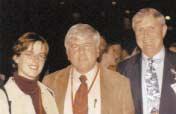
Richard S.Freedman is one of14 new veterinarians to be inducted into Morris Animal Foundation’s Veterinary Honor Roll.Honorees are nominated by donors who contribute $500 or more to the Foundation on behalfofthe veterinarian.“These veterinarians were recognized by their clients for providing service over and above what they would typically expect in veterinary care,”said Dr.Robert Hilsenroth,executive director ofMorris Animal Foundation.Dr. Freedman practices in Charlottesville,Va.
Carol Zoltowski has been recently appointed Vice President,Regulatory Affairs at VIVUS, Inc.,a pharmaceutical company engaged in the development ofinnovative therapies for the
treatment ofquality-of-life disorders in men and women,with a focus on sexual dysfunction.In addition,she continues reliefwork as a clinical veterinarian in San Francisco.
James A.Thomson,a University ofWisconsin-Madison developmental biologist,was presented with the Wilson S.Stone Memorial Award in October 2001 at the 54th Annual Symposium on Fundamental Cancer Research sponsored by The University ofTexas M.D. Anderson Cancer Center in Houston.The award recognizes young researchers who have made outstanding contributions to biomedical sciences in the United States.Dr.Thomson was honored for his pioneering work in the isolation and culture ofnonhuman primate and human embryonic stem cells—undifferentiated cells that have the ability to become any ofthe cells that make up the tissues ofthe body.
During the PVMA’s Annual Meeting in August 2001, Michael R.Moyer was elected Vice-President.He owns Bridgewater Veterinary Hospital,a companion animal practice,in Cornwells Heights,Pa.
Share news with your classmates about a new position or accomplishment, wedding or birth announcement,by sending your class note today! We accept pictures,too,featuring alumni gatherings, whether it’s from a wedding or minireunion.Be sure to identify everyone in the picture.Pictures will be returned only upon request.Send all your submissions to:
Joshua E.Liss Director ofAlumni Relations and Annual Giving University ofPennsylvania School ofVeterinary Medicine3800 Spruce Street Philadelphia,PA 19104-6047
Fax (215) 573-3544
E-mail <lissj@vet.upenn.edu>
Alexandra L.Chisolm-Chait has become board-certified in Internal Medicine-Small Animal by the American College ofVeterinary Internal Medicine.Dr.Chisolm-Chait practices at the Pet Emergency & Specialty Center in La Mesa,Calif.
Mary A.Bryant was elected to a three-year term to the American Veterinary Medical Foundation (AVMF) Board ofDirectors at the AVMA Annual Convention in July 2001.To advance the care and value ofanimals in society,the AVMF distributes nearly $1 million annually in support ofstudent financial aid, scholarships,disaster relief,animal studies and other initiatives.Dr.Bryant is an associate veterinarian at the Wilmington Animal Hospital in Wilmington,Del.She also serves as staff veterinarian and veterinary advisor to Eden Alternative,a program that incorporates pets, children,and plants into nursing home facilities.
Jennifer Chaitman has become board-certified in Internal Medicine-Small Animal by the American College ofVeterinary Internal Medicine.Dr.Chaitman practices at Veterinary Internal Medicine and Allergy Specialists in New York City.
Heather Peikes has become board-certified by the American College ofVeterinary Dermatology.Dr.Peikes practices at Veterinary Internal Medicine and Allergy Specialists in New York City.
1994
Elizabeth Boucher Miquel,a daughter, Lucienne,on July 26,2001.
Jennifer A.Morris,a son,Charles John,on July 19,2001.
Elwood G.Fooder on April 14,1999. Arnold M.Snyder on September 19,2001.
1937
James G.Eagelman on August 12,2001.
1940
Roy S.Harry on October 30,2001.
1941
Bertrand B.Dionne on October 11,2001.
1946
Marvin Alexander on July 24,2001.
1950
Edward D.Bubser on June 16,2001.
1951
William V.Gallery on October 8,2001.
1952
Edward P.Newman in October 2000.
The 102nd annual continuing education conference for veterinarians and veterinary technicians will be held on January 30 and 31 in Philadelphia.
Visit the web site and print the conference brochure: <http://alumni.vet.upenn.edu/ pennannualconference.htm>
Nominations are being sought for three recipients ofthe 2002 Alumni Award of Merit,which will be presented at the Veterinary Medical Alumni Society (VMAS) Annual Meeting during Alumni Weekend 2002 on May 11.The VMAS honors alumni who have made outstanding contributions to their profession and the School with the Alumni Award ofMerit.The award is given annually to recognize distinguished graduates for their contributions that advance knowledge in biomedicine,promote the welfare ofanimals through public education ofanimal owners, and benefit society through civic activities
To find a former classmate and to sign-up for a permanent e-mail forwarding service: Join the University ofPennsylvania Alumni On-Line Community for free at <www.alumniconnections.com/olc/pub/UPN>.
After you register,you can search the On-Line Directory,which is a great resource for personal and professional networking and an easy way to keep up-to-date on fellow alumni. You can also sign-up for a permanent e-mail forwarding service,which will forward messages received at your permanent Penn address to the e-mail address ofyour choice.
To update your alumni record: You can update your record via the University ofPennsylvania Alumni On-Line Community On-Line Directory.You may also contact Elizabeth McNamara at (215) 8981481 or via e-mail at <emcnamar@vet.upenn.edu>.
To make a gift or for information on supporting the School ofVeterinary Medicine: Make a gift with your credit card through a secure online transaction at <www.upenn.edu/gifts>.For information on supporting the School,visit the Alumni & Friends web site at <http://alumni.vet.upenn.edu> or contact Joshua E.Liss at (215) 898-1481 or via e-mail at <lissj@vet.upenn.edu>.
which foster the advancement ofthe profession and the School’s good name.
Eligible 2002 recipients are members of the classes that end in “2”or “7,”and who will be celebrating a five year reunion during Alumni Weekend 2002.Members ofthe VMAS Executive Board will select the recipients from the pool ofnominees.Nominations are due no later than January 25,2002
For more information or ifyou have any questions,please contact Joshua E.Liss, Director ofAlumni Relations and Annual Giving,at (215) 898-1481 or via e-mail at <lissj@vet.upenn.edu>.For a list ofprevious
Alumni Award ofMerit recipients,please visit <http://alumni.vet.upenn.edu/ alumniawardofmerit.htm>.
To make a nomination,please send a letter explaining your reasons to:
Joshua E.Liss
Director ofAlumni Relations and Annual Giving
University ofPennsylvania
School ofVeterinary Medicine
3800 Spruce Street Philadelphia,PA 19104-6047
To request a transcript and/or proofofgraduation:
For information on requesting a transcript,visit the Office ofthe University Registrar’s web site at <www.upenn.edu/registrar/trans.html> or call (215) 898-7511.For information on requesting a certification ofgraduation,which does not require a transcript,contact the School’s Office ofStudent & Curricular Affairs at (215) 898-3525 or via e-mail at <student-affairs@vet.upenn.edu>.
To obtain a Penn Alumni Card:
The Penn Alumni Card offers a myriad of benefits,including access to the Penn Libraries.The charge for the card,which is valid for 10 years,is only $20.Alumni Cards are issued at the PennCard Center,which is located in the Franklin Building at 3451 Walnut Street.In order to receive the card,alumni are asked to show a form ofphoto identification (a valid driver’s license,passport,etc.) and complete an Alumni Card Request Form. It then takes only a few minutes to take a photo ofthe alumnus/alumna and for them to receive their Alumni Card.As an added convenience,alumni can also obtain an Alumni Card by mail.For more information or to download a request form,visit the “Obtaining a PennCard”web page at <www.upenn.edu/penncard/obtaining.html>.
Alumni Relations and Annual Giving Staff: Joshua E.Liss
Director ofAlumni Relations and Annual Giving
(215) 898-1481
Fax (215) 573-3544
E-mail <lissj@vet.upenn.edu>
Elizabeth McNamara
Annual Giving Coordinator
(215) 898-1480
Fax (215) 573-3544
E-mail <emcnamar@vet.upenn.edu>
Please address any correspondence to: Office ofDevelopment and Alumni Relations University ofPennsylvania School ofVeterinary Medicine
3800 Spruce Street
Philadelphia,PA 19104-6047
Tentative Schedule of Events
Friday,May 10–Saturday,May 11
Philadelphia
Friday,May 10—Begin Alumni Weekend 2002 by going back into the classroom!
2:00-3:00 p.m.Alumni Weekend 2002 Classes Without Quizzes Presentation
“My Pet Has Changed:Understanding Aging-Related Behavior Changes in Dogs and Cats” by Dr.Ilana R.Reisner,Assistant Professor ofBehavioral Medicine and Director ofthe Behavior Clinic at the Veterinary Hospital ofthe University ofPennsylvania Houston Hall,Golkin Room,3417 Spruce Street
Learn how to deal with your aging pet from Dr.Ilana R.Reisner,a board-certified veterinary behaviorist.With improved nutrition and medical care,the life expectancy ofour pets has been rising.Hear about the current understanding ofdementia in dogs and cats,and updates on the research and management ofthis common problem.Time will be reserved for questions and answers.
Saturday,May 11—Make it a day on the School’s Philadelphia campus!
8:30-10:00 a.m.Continuing Education Course (E.R.Marookian,V.M.D.,Auditorium,VHUP) Topic to be announced
10:30 a.m.-12:00 p.m.Veterinary Medical Alumni Society Annual Meeting (Marookian Auditorium)
See your Alumni Society at work,and watch the presentation of the 2002 Alumni Award ofMerit to three graduates celebrating a class reunion in 2002
12:00-2:30 p.m.Alumni Day Picnic (Hamilton Village,across Spruce Street from the School)
Enjoy a buffet-style luncheon with alumni,special activities will be available for children at Kid’s Corner
2:30-3:30 p.m.Parade of Classes (Locust Walk)
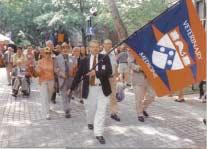
Show your school spirit by participating in one ofPenn’s favorite traditions
3:00-4:30 p.m.Tours of VHUP,Philadelphia Research Facilities
5:00-6:30 p.m.Dean’s Alumni Reception (University ofPennsylvania Museum of Archaeology and Anthropology,33rd & Spruce Streets)
6:30 p.m.Alumni Dinner Honoring the 2002 Reunion Classes (years ending in “2”or “7,” University Museum)
Make your hotel and travel plans early!
For your convenience, rooms have been reserved throughout Philadelphia for alumni attending Alumni Weekend 2002.To make your reservations,contact Fran A.Engelbach, CW’62,at Monarch Travel Services,Inc.,at (215) 557-7177 or tollfree at (800) 458-7177.
A brochure with registration information will be sent early in 2002.For more information on Alumni Weekend 2002, please contact Joshua E.Liss,Director ofAlumni Relations and Annual Giving,at (215) 898-1481 or via e-mail at <lissj@vet.upenn.edu>.
New Bolton Center celebrates its 50th birthday in 2002.
We are collecting stories and reminiscences about New Bolton Center.
Share your New Bolton Center memories with us.We would like to hear from those ofyou who were at New Bolton in the last five decades.
Please send your “memories”to Jane Simone via email <jsimone@vet.upenn.edu> or via mail to her at New Bolton Center,382 West Street Road,Kennett Square,PA 193421692

Dr.John Melniczek,V’92,post-doctoral fellow in medicial genetics,re-joined the clinical staffofthe Section ofMedical Genetics and has been assisting Drs.Urs Giger,Margret Casal and Hamutal Mazrier in expanding the clinical and laboratory services offered to VHUP clinicians and referring veterinarians.
Along with a strong clinical and research background in the field ofmedical genetics,he brings with him a great interest in identifying and correcting,where possible,canine and feline reproductive problems,and in assisting owners in pediatric care and genetic counseling.Artificial insemination will now be available in canine infertility cases that the primary clinician believes could benefit from such a procedure.
Dr.Melniczek will also be available to answer questions regarding the Section’s four laboratories:the metabolic screening laboratory
Established in 1982,the Pet Memorial Program has grown from a handful of veterinarians to a large group ofpractitioners across the country who make gifts in memory ofclients’pets.The funds raised enhance teaching and service,which in turn helps the Veterinary Hospital ofthe University ofPennsylvania (VHUP) provide the best veterinary care for its companion animal patients. Those veterinarians who participate in the Program agree that it is an excellent client relations tool,and they have received wonderful
responses from their clients upon being informed that a gift to VHUP has been made in memory oftheir pet.Ifyou do not already participate,you are encouraged to do so. The Program has been recently reviewed to make it more efficient for both the School and the participating veterinarians.Beginning on January 1,2002,notification cards will be sent by veterinarians instead ofthe School.This decision was made in consultation with several ofthe participating veterinarians,and will
which seeks to identify patients that might have inherited metabolic disorders;the hematology laboratory that provides assistance in identifying blood compatibility products for patients through the blood bank,and in the identification ofcanine and feline blood disorders;the cytogenetics laboratory that identifies patients who have disorders ofsexual development;and the newest laboratory,the Josephine Deubler Genetic Disease Testing Laboratory,which has been identifying carriers and affected animals for a variety ofbreed-specific genetic diseases in cats and dogs.
To inquire about referrals for patients with reproductive,pediatric,or genetic problems,or to ask questions about the services provided by the laboratories,Dr.Melniczek and the rest of the Section ofMedical Genetics’staffcan be reached at 215-898-4680 or at http://www.vet.upenn.edu/penngen.
streamline the administration ofthe Program. For each tax-deductible contribution of $100 to the School,participating veterinarians will receive 10 note cards to send to their clients.Not only will this support enhance their client relations’efforts,it will help to maintain VHUP’s standard ofexcellence.
For more information or for card order forms,please contact Elizabeth McNamara, Annual Giving Coordinator,at (215) 898-1480 or via e-mail at <emcnamar@vet.upenn.edu>.
Binni,a 10-month-old Chihuahua,was referred for treatment to the pediatric and genetic service at VHUP by Trooper Veterinary Hospital in Norristown,Pa.The dog had developed a large,painful hematoma over his back caused by hemophilia,a common, severe,hereditary bleeding disorder that affects males.Transfusion ofclotting factors can stop the bleeding and be life-saving.
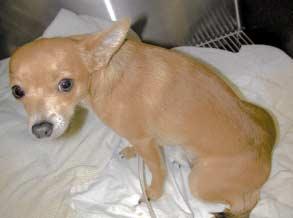
The Penn Animal Blood Bank (PABB) collects and prepares thousands ofunits ofblood products each year for VHUP’s patients.The blood and blood products are typed and carefully screened for known and emerging infectious diseases to prevent transmission ofsuch diseases to patients.
Blood consists oftwo portions:a liquid portion,called plasma,and a cellular portion, consisting ofred blood cells,white blood cells
and platelets.Each cellular component has its own function within the body:red blood cells are responsible for carrying oxygen from the lungs to all vital tissues and organs,white blood cells help the body fight infection,and platelets are a necessary part ofthe body’s clotting mechanism.Plasma acts as a carri-
Would you consider a charitable gift of $10,000 or more if you could retain an income interest in assets that you give away?
We are pleased to offer several philanthropic plans that let you do just that.
Charitable remainder trusts offer outstanding planning flexibility,with rates starting at 5%.
Charitable gift annuities offer guaranteed fixed income for life at rates of6% to 9.5% (may be higher ifyou defer income).
All ofPenn’s Life Income Gift Plans offer you:
• Current income tax deduction
• Significant capital gains tax savings
• Guaranteed income for life or a term ofyears
• Option to defer income for higher income and deduction
• No management fees for gift annuities,low fees for trusts
• Enduring support for the School ofVeterinary Medicine, VHUP,or New Bolton Center
For more information or a personalized illustration with no obligation, call Penn’s Office ofGift Planning at 800-223-8236 or email <planned_giving@ben.dev.upenn.edu>.Be sure to mention the Bellwether.
Life income gifts may be funded with cash,marketable securities,or other assets in some cases.Income may be current or deferred.Rates and deductions vary with age and number ofincome beneficiaries and the timing ofthe gift.Penn gift annuities are not available in all states.Minimum gift amount is $10,000 for charitable gift annuities and $100,000 for charitable remainder trusts.Thank you.
er system for these cells,as well as many important proteins,vitamins and nutrients.
When a unit ofblood is collected from a donor,all ofthese components are represented, and the blood is referred to as whole blood.In most cases,a seriously ill animal does not need whole blood but just one or two components. Therefore,the PABB nursing staff,after returning from volunteer canine blood drives in the Delaware Valley,separates the blood into its components with the help oftechnologically advanced equipment.“One unit ofcollected blood benefits more than one patient,”says Donna Oakley,director ofPABB and VHUP nursing.“A patient can be treated specifically with only the component needed.This reduces the risk ofadverse reactions.”Some ofthe blood components can be stored for a month and others for one year and are immediately available in an emergency.Because ofthe large size difference between dog breeds,blood units ofdifferent sizes are needed.“Although we are applying blood banking standards from human medicine,we had to develop comparable methods for our small patients,such as toy breeds and cats,”says Wendy Hatchett,another PABB nurse.
Binni needed to be transfused with a small unit ofplasma twice daily for a couple ofdays to achieve resolution ofthe hematoma and further healing.Because hemophilia is a hereditary disorder,it is likely that Binni will have recurrences.Specific small units have been prepared and are readily available for his treatment in the future.
PET CARE IN THE NEW CENTURY:Cutting Edge Medicine for Dogs and Cats by Amy Shojai. New American Library (Penguin Putnam Inc., 375 Hudson St.,New York,NY 10014.)
Paperback,$14.00.
Here is an up-to-date reference book covering modern veterinary care.More than a hundred veterinarians,among them quite a few from Penn,(listed in an appendix) explain many health and behavior conditions,arranged alphabetically.There are notes on contact lenses as a diagnostic aid as well as protective glasses.Tests for hearing loss are discussed and hearing aids that are available.Pacemakers are used for some heart problems in dogs.Kidney transplants are used for cats.The topics include aggression,cancer,cognitive disorders,obesity, pain,parasites and vaccinations.“Modern Miracles”describe results ofinnovative treatments.
The appendix lists veterinary colleges in the United States and their websites.A specialist has completed additional training and is a “Diplomate”ofa veterinary specialty college. The appendix gives contact information. Among the specialties are internal medicine, dermatology,ophthalmology,surgery,radiology,nutrition and behavior.Most have websites listing members.
The human-animal bond brings up ethical questions,which are thoughtfully covered.New procedures may receive much publicity,but their effectiveness has not been proven.Pet insurance now is available to help cover the cost.It may cover experimental treatments,but not pre-existing or inherited conditions.Some owners never question the cost ofsaving a pet’s life while others consider spending a “fortune” a poor ethical choice.Is there an answer?
The difficult subject ofgenetics is briefly covered.Molecular medicine looks for causes ofdisease in the genes.Research has identified the genes involved in many canine and feline diseases and tests can be used to identify suspected carriers.
This book covers many advances in veterinary medicine and shows you how to take advantage ofthem.It’s a worthwhile addition to the library ofdog and cat owners.
Paint and Quarter Horses lead in registrations,followed by Thoroughbreds,Tennessee
Walking Horses,Standardbreds,Appaloosas, Arabians,Morgan Horses and Saddlebreds.
The average price ofThoroughbred yearlings sold at auction in 2000 was $54,506.
Kentucky is the foundation ofthe Thoroughbred breeding industry with 416 stallions and 20,616 mares bred in 2000.

The average horse eats 11,000 pounds of hay,grass and grain each year.On average,a horse consumes two to three ounces ofsalt daily.During moderate work,it can lose 1.75 to 2.2 ounces ofsalt in his sweat and 1.25 ounces in urine.A horse will consume as much sodium as it needs when offered salt free choice.
Anthrax is a disease which occurs in almost all warm-blooded animals and humans.The disease is also called Charbon,Milzbrand and Splenic Fever.The human form is known as woolsorters’s disease.It occurs worldwide.In the United States there are recognized areas of infection but it has not been seen in Pennsylvania for decades.
The cause is Bacillus anthracis,a sporeforming bacterium.The spores may remain viable for decades.Infection ofherbivores occurs when they graze in areas where spores in the soil are activated by change in conditions such as flood or drought,especially ifthe temperature is over 60 degrees.Other species are infected when they eat meat ofanimals dead of anthrax,get contamination ofskin cuts or inhale large numbers ofspores.The generalized form is characterized by rapid onset and may be rapidly fatal.Localized infections usually respond to treatment.Intestinal anthrax is acquired by eating raw or undercooked infected meat.
The first vaccine for anthrax was made by Pasteur in 1879 and annual vaccination of grazing animals can control the disease in endemic areas.Ciprofloxacin is the antibiotic ofchoice for treatment,although the organism is sensitive to a large number ofantimicrobials. It is important that regulatory officials be notified ifthe disease occurs or is suspected so appropriate control measures can be taken.
Anthrax spores manufactured for criminal purposes can have the appearance ofa white powder.Ifthere are suspicious circumstances, local law enforcement authorities should be notified.
Factual information concerning various forms ofbiological and chemical agents and the mail may be found at:
Center for Disease Control — http://www.chc.gov
United States Postal Service — http://www.usps.gov
Pennsylvania Department ofHealth — http://www.health.state.pa.us
University ofPennsylvania School ofVeterinary Medicine
Editor
Helma Weeks
Photographers
Jon Adams
Addison Geary
Doug Thayer Writers
Stephen Bradt
Dr.Josephine Deubler
Joan Capuzzi Giresi,V.M.D.
Patrick A.Mahaney,V.M.D.
Alumni Relations Liaison
Joshua E.Liss
New Bolton Center Liaison
Jeanie Robinson-Pownall
We’d like to hear your praise,criticisms,or comments.Please address your correspondence to:
Helma Weeks
University ofPennsylvania
School ofVeterinary Medicine
3800 Spruce Street Philadelphia,PA 19104-6010 (215) 898-1475
hweeks@vet.upenn.edu
None ofthese articles are to be reproduced in any form without the permission ofthe editor of Bellwether.
©Copyright 2001 by the Trustees ofthe University ofPennsylvania.
The University ofPennsylvania values diversity and seeks talented students,faculty and stafffrom diverse backgrounds.The University ofPennsylvania does not discriminate on the basis ofrace,sex,sexual orientation,religion,color,national or ethnic origin, age,disability,or status as a Vietnam Era Veteran or disabled veteran in the administration ofeducational policies,programs or activities;admissions policies;scholarship and loan awards;athletic,or other University administered programs or employment. Questions or complaints regarding this policy should be directed to:Executive Director,Office ofAffirmative Action and Equal Opportunity Programs,3600 Chestnut Street,Sansom Place East,Suite 228, Philadelphia,PA 19104-6106 or (215) 898-6993 (Voice) or (215) 898-7803 (TDD).
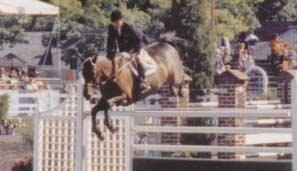
The American Gold Cup was held September 13 to 16 at the Devon Show Grounds.Events ofSeptember 11 cast a big shadow.Everyone wore red-white-and-blue ribbons and collections were taken for victims and survivors.Friday afternoon and evening activities were cancelled in deference to the national day ofmourning.
and Christine Connelly enjoyed their assignment and awarded numerous prizes.Many children came with drawings and paintings and participated in the art show.Sunday featured the grand finale,the competition for the American Gold Cup.It was won by Kimberley Frey on Berberac.
The School’s booth was easily identifiable by the lifesize wooden Harnessmaker’s horse that the New Bolton Center crew had suspended from a tree.
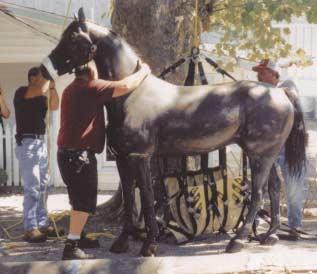
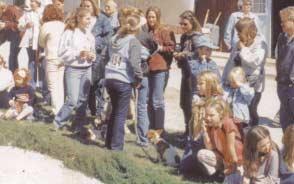 Stupine
Stupine
Saturday featured added classes in the Dixon Oval.The day was packed with activities.The celebrity dog show drew a large entry and a large crowd.Judges Barry
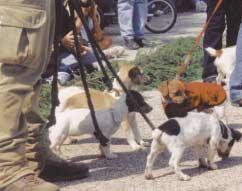

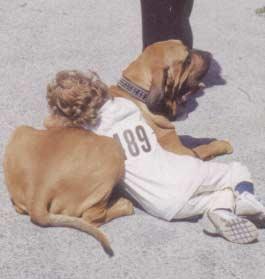
The following gifts were made to Friends of New Bolton Center in memory of a special animal:
The Davis/Hirsch Family in memory of“CAESAR”
Dr.Carol Anne Dolinskas in memory of“RULY”
Ms.Elizabeth W.Glascock in memory of“LANCELOT”
Hilltop Farm and Mrs.Jane MacElree in memory of “ROYAL RENDITION”
Mr.and Mrs.John P.McFadden,Jr.in memory of “MOSELLE”
Ms.Allison Schomber in memory of“VEOLETTE”
The following gifts were made to Friends of New Bolton Center in honor of those listed:
Ms.Beverly Barnes in honor ofSheba and Ally Barnes
Mr.and Mrs.John S.Craig in honor ofDr.Dan Morris
Kenneth K.Sadanaga,V.M.D.in honor ofDr.Jill Beech’s appointment as the Georgia E.and Philip B.Hofmann Professor in Equine Medicine & Reproduction
Ms.Barbara Silverstein in honor ofMr.Tom Taylor
The following gifts were made to Friends of New Bolton Center in memory of Mr.James Armstrong:
Mr.and Mrs.Vladimir Borodavchuk
Ms.Edna S.Moore
Ms.Helen K.Pople
Mr.and Mrs.Pete Tester
The following gifts were made to Friends of New Bolton Center in memory of Ms.Diana Muss:
Mr.and Mrs.Lewis I.Gantman
Mr.Louis I.Gantman
Mr.Art Powell
Mr.Harold Schaeffer
Mr.Wayne Snyder
The employees ofthe Kravco Company
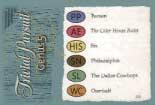
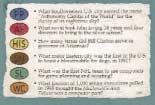
Ifyou play Trivial Pursuit Genus 5 you may draw a card that asks “What major Eastern city was the first to boast a bloodmobile for dogs,in 1991?”
The answer is:Philadelphia (at VHUP, ofcourse!)
The following have made gifts to the Veterinary Hospital of the University of Pennsylvania in memory of a special pet: John H.Abrams & Judith S.Everitt in memory of “HENRY”
Ziva Simon Alon in memory of“ELZA”
Amy L.Anderson in memory of“RICO”
Ms.Robin Bausback in memory of“MOLSON GOLDEN”
Mr.Stephen F.Bezuk in memory of“MISTY”and “MISTER BAD”
Mrs.Jacqueline Bofinger in memory of“CASEY”
Mr.and Mrs.John Capuzzi in memory of“MOLLY”
Mr.and Mrs.Chadwick in memory of“RASCAL”
Mr.and Mrs.Eugenio Chinigo in memory of“BRANDY” & “BIANCA”
Mr.Oliver B.Cospelich in memory of“PHAROAH”& “BART”
Ms.Nancy Dagle in memory of“SEDGEWICK”
Ms.Teresa A.Demusis in memory of“RASCAL”
Ms.Judith DeStefano in memory of“CLEOPATRA”
Ms.Sally Evans in memory of“INKY”
Mr.and Mrs.Chris Fahey in memory of“PEPPER”and “CINNAMON”
Ms.Marjorie Fein-Deutsch in memory of“JESSICA”
Ms.Yvonne Ehrhart in memory of“DIXIE”
Mr.and Mrs.Mulford E.Emmel in memory of “ABERCROMBIE”
Mr.Richard Feldman in memory of“NIGEL”
Ms.V.Susan Fisher in memory of“SOPHIE”
Mr.and Mrs.Jeffrey Gelfand in memory of“KOTI”
Ms.Susan Gibson in memory of“MAGGIE”
Mr.and Mrs.Scott Green in memory of“COCO”
Ms.Eileen Haley in memory of“SENNA”
Ms.Meredith Heckler in memory of“MOLLY”
Ms.Carolyn Heiser-Wood in memory of“MAXWELL OLIVER”
Mr.William Hoffman in memory of“CHACO”
Ms.Lily Hoge in memory of“PETIE”and “EMMA”
Ms.Joan Kaufman in memory of“PRINCE”
Mr.and Mrs.Stephen Kazakoffin memory of“NUGGET”
Ms.Joan Kistler in memory of“MAXINE”
Ms.Joan Kistler in memory of“PRINCE”& “SPARKY”
Mr.John Kurten in memory of“LUCKY”
Ms.Elizabeth Langan in memory of“CEILI”
Ms.Bernadine A.Lennon in memory of‘SHADOW”
Ms.Wendy Mace in memory of“SPARKY”
Ms.Wendy Margolis in memory of“SOPHIE”
Tomi J.McCann,M.D.in memory of“BUDDY “ and “PEDO”
Ms.Betty Louise McCurdy in memory of“HERKIMER”
Nancy A.McDermott in memory of“MUFFY”
Mr.and Mrs.James A.McMillan in memory of“ROCKY”
Mr.David J.Mealmaker in memory of“NUNZIO”
Mr.Jerry Michaels in memory of“GOLDY”
Mrs.Judith Morlacci in memory of“NIKKI”
Ms.Sonya Peterson in memory of“PJ”
Ms.Marie Pinizzotto in memory of“CHRISSY”
Mr.and Mrs.James Olive in memory of“PEBBLES”, “REINA”& “BONNIE”
Ms.Mary Rice in memory of“SUGAR PIE”
Mr.and Mrs.Carl Rulis in memory of“BRANDY”
Mr.and Mrs.Gregg Runyen in memory of“MEGGIE”
Ms.Susan A.Schmidt in memory of“FRITO BANDITO”
Mr.and Mrs.Paul J.Schoffin memory of“PIPER”
Ronni and Lester Schwartz in memory of“TANYA”
Ms.Randi S.Semanoffin memory of“CHLOE”
Mr.and Mrs.Paul Seymour in memory of“COCO”
Mr.Joseph Sgro in memory of“MOLLY”
Mr.Gene W.Sharpless in memory of“SANDY”
Mr.and Mrs.Rocco Siravo in memory of“NOEL”
Ms.Diane Sjolander in memory of“MOLLY”and “SAGE”
Mr.and Mrs.Charles W.Smith in memory of “SAMANTHA”
Kathryn Staci in memory of“BANDIT”
Kathryn Staci in memory of“SONJA”
Ms.Lisa Stanwyck in memory of“TAD”
Mr.Michael Telenda in memory of“YUKON”
Mrs.Helma N.Weeks in memory of“ROMEO”
Mr.and Mrs.Richard Walters in memory of“JESSIE”
Ms.Mary Kay Washo in memory of“BRIGETTE RED”
Ms.Kathleen Wert in memory of“FRITZ”,“NIKKI”and “LUCKY”
Ms.Linda Weyler in memory of“BLACKIE”
Ms.Stephanie Yarbough in memory of“SASHA”and “DIRTY FACE”
The following have made gifts to the Veterinary Hospital of the University of Pennsylvania in memory of Terry Woods: Action Duplication,Inc.
Mr.and Mrs.Wayne A.Althouse
Martha L.Ames
Philomena T.Andreoni
Christine Augustine
Mrs.Joan T.Buck
Mr.and Mrs.Ronald O.Buck
Sheila M.Bury
Michael W.Carr
Pamela Davis
Mr.and Mrs.Del Viscio
Mr.and Mrs.Jeffrey J.Destefano
Joanne DiCampli
Lynn M.Dignazio
Denise M.Durbano
Henry J.Frentzen
Mr.and Mrs.Kenneth Grant
Mr.and Mrs.James Klecko
Carol Ann Kruklis
Judith M.Lowenstein
Mr.and Mrs.Walter Mackin
Mr.and Mrs.David Madden
Mr.and Mrs.Matthew C.Maturani
Mr.and Mrs.Joseph Mundy,Sr.
Mr.and Mrs.James Nasella
Kathleen E.Parente
Pamela Jean Parker
Gale Ranalli
Mr.and Mrs.Samuel C.Schmeltzer
Lori Solomon
State Farm Mutual Automobile Insurance Company State Farm Insurance Companies
Tanya Lee Tumas
Robert Woods
Carolyn Zimmerman
The following have made gifts to the Veterinary Hospital of the University of Pennsylvania in memory of Jack Glover:
Mr.and Mrs.Robert P.Corlies
Clifford P.Crowers
Mr.and Mrs.Richard Lippin
Doris Marie Londer
Mrs.Zoreslava L.Mysko
Helen Mae Mullen
Mr.and Mrs.Owen Regan
Mr.and Mrs.Harry B.Reiff
The following have made gifts to the Veterinary Hospital at the University of Pennsylvania in memory of those listed:
Linda Bergh in memory ofE.Joanne Bristol
Mr.and Mrs.Bernard Brewstein in memory ofSara Jane Dickstein
Frances M.Iadevaio in memory ofJoseph P.Sanfilippo
Mr.and Mrs.Arthur Kast,Jr.in memory ofSusie Kast
Ms.Diane Mengel in memory ofDr.Robert B.Weber
Mr.and Mrs.David A.Miller in memory ofJohn Johnson
Ms.Maryjeannette J.Monihan in memory ofDr.W.M. Gallery
The following have made gifts to the Veterinary Hospital of the University of Pennsylvania in honor of a special pet:
Ms.Tammy James in honor of“RIDLEY”
Ms.Sheree Mazzella in honor of“MAXWELL”
Mr.and Mrs.Don O’Connor in honor of“MISSY”and “RUSTY”
Mr.and Mrs.Rocco Siravo in memory of“NOEL”
The following have made gifts to the Veterinary Hospital of the University of Pennsylvania in honor of those listed:
Mr.and Mrs.Nicholas Christopher in honor ofDrs.Ann Wayne Lucas and Diane DeLorenzo’s work at Washington Square Animal Hospital
Ms.Helen Davenport in honor ofDr.Christopher Donner
Mr.and Mrs.C.D.Deringer in honor ofthe 30th Anniversary ofBarbara and Larry Magic
Ms.Tammy James in honor ofDr.Chick Weisse
Mr.and Mrs.Arthur Kast,Jr.in honor ofDr.Prudence Neath
Mr.James Koch and Ms.Karen Bossert in honor ofDr. Chick Weisse and Dr.Tona Melgarejo
Ms.Margie Levi in honor ofNathan’s birth
Robin M.Mazin,V.M.D.in honor ofDr.Cynthia Otto’s contribution to the WTC search and rescue mission
Ms.Carolyn B.Pope in honor ofDr.Christiansen for his work with Julio Pope
Mrs.Letitia O.Principato in honor ofRaymond A. Harding
Mr.and Mrs.Robert Rapiejko in honor ofDr.Tracy Springer
Ms.Linda Weyler in honor ofDr.Lilian Duda and Dr.Amy Kapatkin
The following have made gifts supporting Epilepsy Research in memory of a special pet:
Mr.and Mrs.Barry Miller in memory of“FLUFFY”
The follow have made gifts to the Clinical Studies Research Development Fund in memory of Juno:
Ms.Patricia diPietrae
Mrs.Patricia Hall
Mrs.Jennifer Liss
Mr.Joshua Liss
Ms.Marie McEntee
Ms.Catherine McNamara
Ms.Susan Mullins
Ms.Jeanie Robinson-Pownall
Mr.Timothy Rupe
Mrs.Jane Simone
Mr.Mark Stuart
Ms.Ellen Tarasca
Ms.Helma Weeks
Ms.Andrea Withers
The follow have made gifts to the Clinical Studies Research Development Fund in memory of Katie:
Mrs.Patricia Hall
Dr.David Holt
Mrs.Jennifer Liss
Mr.Joshua Liss
Ms.Marie McEntee
Ms.Elizabeth McNamara
Mrs.Amy-Lynn Parkman
Ms.Jeanie Robinson-Pownall
Mr.Timothy Rupe
Mrs.Phyllis Sewall
Mrs.Jane Simone
Mr.Mark Stuart
Ms.Ellen Tarasca
Ms.Andrea Withers
The following have made gifts to the Special Species Medicine Clinic in honor of a special pet:
Mrs.Dana Goodyear in honor of“FOUR STEP ROSE”
Mr.and Mrs.Andrew R.Budman in honor of“COOKIE”
The following have made gifts to the Special Species Medicine Clinic in honor of those listed:
Mr.and Mrs.Andrew R.Budman in honor ofDr.Karen Rosenthal
The following have made gifts to the Josephine Deubler Student Scholarship in honor of those listed:
Mr.Dale C.Deubler in honor ofM.Josephine Deubler, V.M.D.
The following have made gifts to the Josephine Deubler Genetic Disease Testing Laboratory in memory of a special pet:
Ms.Phyllis N.Sewall in memory of“LACEY”
The following have made gifts supporting Soft Coated Wheaten Terrier Research in memory of a special pet:
Mr.Richard Tomlinson in memory of“GINGER”
The following have made gifts supporting Diabetes Research in memory of a special pet:
Ms.Christine Lally in memory of“LADY”
The following have made gifts supporting Oncology Research in memory of a special pet:
Ms.Catherine Ciric in memory of“BU”
Mr.and Mrs.Steven Conant in memory of“HANNAH”
Mr.and Mrs.Raymond J.Higgins in memory of “STEPHANIE”
Ms.Carolyn B.Pope in memory of“ROMEO”
The following have made gifts supporting Oncology Research in honor of those listed:
Ms.Carolyn B.Pope in honor ofDr.Lisa Barber
The following have contributed gifts to the Dean’s Fund in honor of those listed:
Mrs.Carolyn R.Cotter in honor ofDr.Lesley King
Mrs.James S.Vandermade in honor ofDr.David Detweiler
The following have contributed gifts to the Dean’s Fund in memory of those listed:
Stephen R.Levan,V.M.D.in memory ofRussell S.Detwiler, V.M.D.
Ms.Kathleen McSherry in memory ofMary and Joseph McSherry
Karen Seamans in memory ofMr.Earl Holton
The following have contributed gifts to the Dean’s Fund in memory of a special pet:
Betsy Dayrell-Hart,V.M.D.in memory of“TOSCA”
Mr.and Mrs.Paul Seserko in memory of“HOLMHAVEN JASON OF SEALOCH”
Ms.Margaret Yeaw in memory of“BIG KITTY”
The following have contributed gifts to the Clinical Studies Critical Care Fund in honor of those listed:
Mrs.Roberta M.Webb in honor ofDr.Bisque Jackson
The following have contributed gifts to the Chinchilla Research Fund in memory of those listed:
Estate ofHelen S.White in memory ofHelen White
The following have contributed gifts to Veterinary Student Scholarship in memory of those listed:
Richard G.Ainley,V.M.D.in memory ofRobert Ainley Vanderhoof,V.M.D.
Cathy A.Ball,V.M.D.in memory ofSister Catherine Henrietta
William Deeds Donovan,V.M.D.in memory ofDr.Sam Scheidy
Barbara L.Henderson,V.M.D.in memory ofThomas A. Henderson
Dr.Christopher Morris in memory ofDr.Robert B.Weber
Lawrence W.Samples,V.M.D.memory Dr.Robert B.Weber
Mr.and Mrs.Charles Thompson in memory ofIrvin Hymerling
The following have contributed gifts to Veterinary Student Scholarship in honor of those listed:
Joseph F.DiMauro,V.M.D.in honor ofLoren Evans, D.V.M.
Horsham Veterinary Hospital,P.C.in honor ofLoren Evans,D.V.M.
Michael S.Miller,V.M.D.in honor ofDr.David K. Detweiler
Dr.Barbara Ruch in honor ofDr.Suzanne R.Jenkins
The following have contributed gifts to Veterinary Student Scholarship in memory of a special pet:
Mr.and Mrs.Nicholas J.Masciulli in memory of“SPOTS”
Ms.Marilyn S.Wiesen in memory of“POKEY”
The following have contributed gifts to the E.R.Marookian Research Scholarship Fund in honor of Dr.Edgar R.Marookian:
Mr.and Mrs.Edward Elmasian
Mr.and Mrs.Paul Jaffarian
The School received $60,000 from the estate of Jean Shepherd to establish a scholarship for women in the name ofLeigh Brown Shepherd.Jean Shepherd died in October 1999 at the age of78,he was a resident ofSanibel Island,Fl.
Mary R.Romig-DeYoung,through her estate,provided $250,000 for an endowment fund to support animal care and treatment at VHUP.Mrs.Romig-DeYoung, who died in October 2000,was a long-time supporter ofthe University.
Thoroughbred Charities ofAmerica contributed $50,000 to New Bolton Center for equipment for the Scott Equine Sports Medicine Building.This organization is a charity created by Herb and Ellen Moelis, long-time supporters ofthe School.Herb is a member ofthe School's Board of Overseers.
General Econopak,specialists in surgical apparel and products,made a donation of $30,000 to the School.General Econopak has had a long-standing relationship with the School and its hospitals.Halfofthe funds will be used at New Bolton for the purchase ofequipment.The remainder will be used at VHUP for installation ofexternal nitrogen lines to power special equipment in the surgery suites.A bequest of $10,000 from the estate of Lynne Wickenden will also be applied to this VHUP project.
5-10
Pennsylvania Farm Show 2002
Farm Show Complex
Harrisburg,PA
Visit the School ofVeterinary Medicine’s booth at the largest indoor agricultural event in America.For information,visit <http://sites.state.pa.us/PA_Exec/ Agriculture/bureaus/farm_show/2002/welcome/ welcome.htm>.
13
8:00-10:00 p.m.
Alumni Reception
The North American Veterinary Conference Grand Caribbean Ballroom II Caribe Royale Orlando,FL
26
Annual Canine Symposium for Owners and Breeders
E.R.Marookian,V.M.D.Auditorium
Veterinary Hospital ofthe University ofPennsylvania
For information,call Dr.Josephine Deubler at (215) 898-8862 or visit <www.vet.upenn.edu/ comm/news/2002symposium.html>.
30-31
2002 Penn Annual Conference
Adam’s Mark Hotel
Philadelphia,PA
For information,visit <http://alumni.vet.upenn.edu/ pennannualconference.htm>.
30
2:00-4:00 p.m.
Veterinary Medical Alumni Society Executive Board Meeting at 2002 Penn Annual Conference
13
2:00-4:00 p.m.
Veterinary Medical Alumni Society Executive Board Meeting
Alumni Hall
New Bolton Center
Kennett Square,PA
23
Annual Feline Symposium for Owners and Breeders
E.R.Marookian,V.M.D.Auditorium
Veterinary Hospital ofthe University ofPennsylvania
For information,call Dr.Josephine Deubler at (215) 898-8862 or visit <www.vet.upenn.edu/ comm/news/2002symposium.html>.
8
2:00-4:00 p.m.
Veterinary Medical Alumni Society Executive Board Meeting Veterinary Hospital ofthe University ofPennsylvania
10-11
Alumni Weekend 2002/Reunions for Classes ending in “2” or “7”
For information,visit <http://alumni.vet.upenn.edu/ alumniweekend2002.htm>.
10
2:00-3:00 p.m.
Alumni Weekend 2002 Classes Without Quizzes Presentation “My Pet Has Changed:Understanding Aging-Related Behavior Changes in Dogs and Cats” by Dr.Ilana R.Reisner,Assistant Professor of Behavioral Medicine and Director ofthe Behavior Clinic at the Veterinary Hospital ofthe University of Pennsylvania
Houston Hall,Golkin Room 3417 Spruce Street
Learn how to deal with your aging pet from Dr.Ilana R.Reisner,a board-certified veterinary behaviorist.With improved nutrition and medical care,the life expectancy ofour pets has been rising. Hear about the current understanding ofdementia in dogs and cats,and updates on the research and management ofthis common problem.Time will be reserved for questions and answers.
13
School of Veterinary Medicine Class of 2002 Commencement
University of Pennsylvania
School of Veterinary Medicine
3800 Spruce Street
Philadelphia,PA 19104-6008
Address service requested